Notas para un Manual del Fiscal - Consórcio Português de Conservas de Sardinha
Dirigido a Joze Antonio Affonso Barboza
Escrito por José Abeijon Mora, industrial de Matosinhos, da fábrica Pinhais. Abeijon foi um dos impulsionadores da revista Conservas.
Participam nos textos Maria Ortiz, Oliván e Imanol Beleak
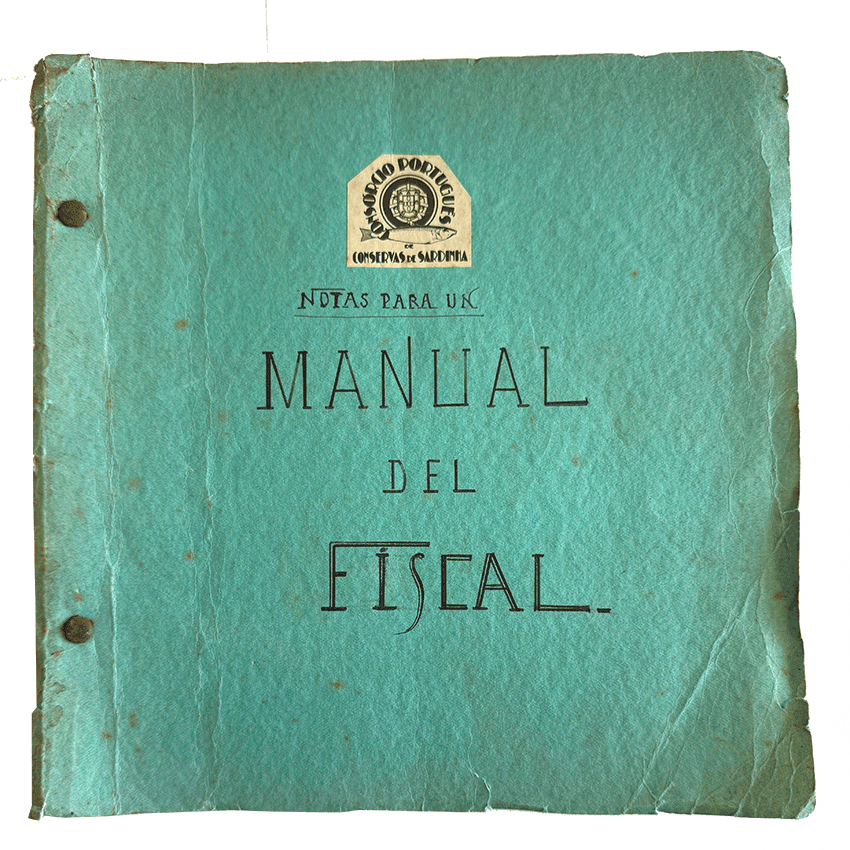
OWNER OF COLLECTION: conservasdeportugal.com
CREDIT:
IMAGES: Museu Digital Conservas de Portugal
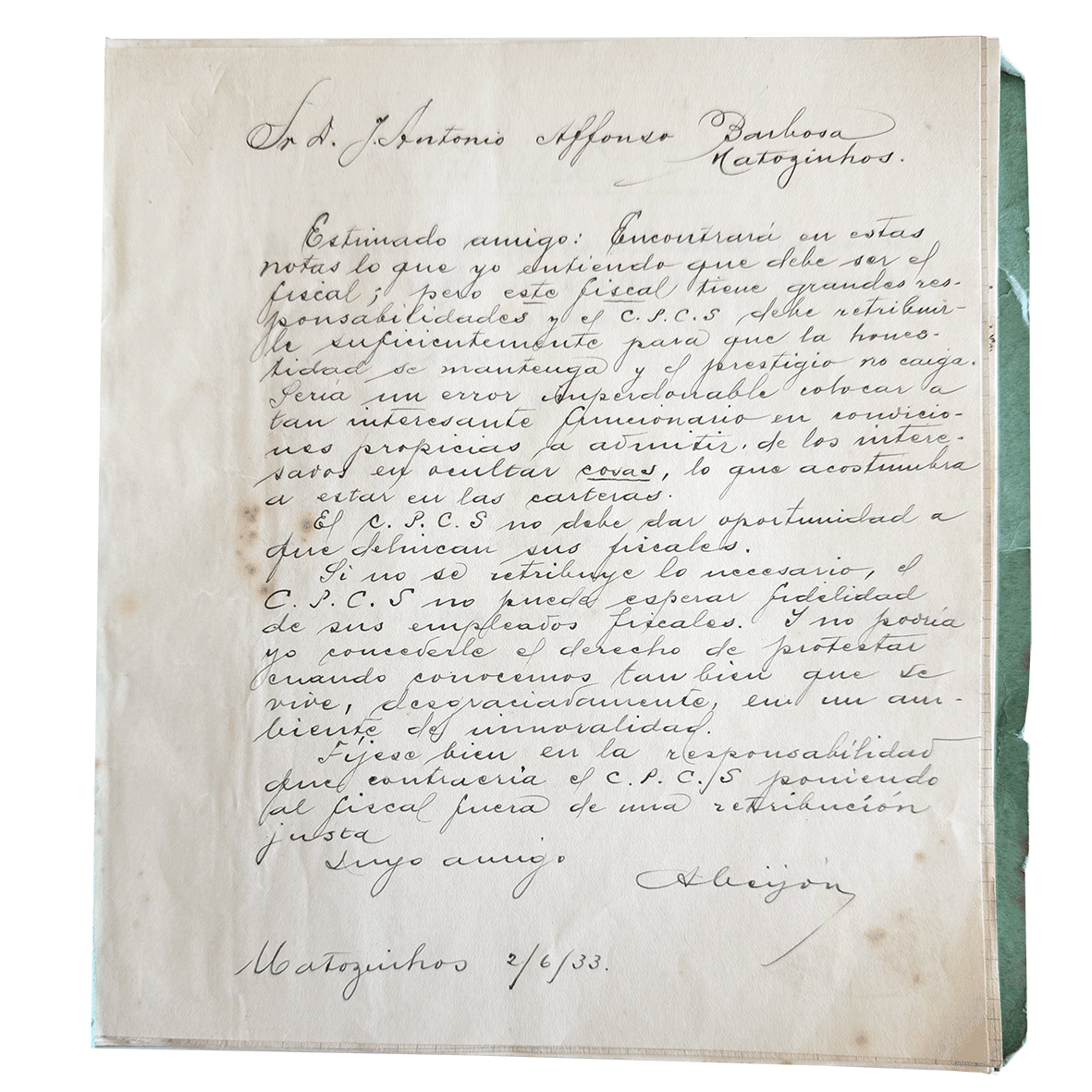
Sr. D. J. Antonio Affonso Barbosa
Matosinhos
Estimado amigo: Encontrará en estas notas lo que yo entiendo que debe ser el fiscal; pero este fiscal tiene grandes responsabilidades y el C.P.C.S* debe de retribuirle suficientemente para que la honestidad se mantenga y el prestigio no caiga.
Sería un error imperdonable colocar la tan interesante funciónario en condiciones propicias a omitir, de los interés en ocultar cosas, lo que acostumbra a estar en las carteras.
El C.P.C.S.* no debe dar oportunidad a que denigren sus fiscales.
Si no se retribuye lo necesario, el C.P.C.S. no puede esperar fidelidad de sus empleados fiscales. Y no podía yo concederle el derecho de protestar cuando conocemos también que se vive, desgraciadamente, en um ambiente de imoralidade.
Piense bien en la responsabilidad que contrairía el C.P.C.S. poniendo al fiscal fuera de una retribución justa.
Suyo amigo,
Abeijon**
Matosinhos 2/6/1933
*Consórcio Português de Conservas de Sardinha
** José Abeijon Mora
Mr J. Antonio Affonso Barbosa
Matosinhos
Dear friend, In these notes, you will find what I understand the role of the inspector should be; however, this inspector bears great responsibilities, and the C.P.C.S. must compensate him adequately so that honesty is upheld and prestige does not falter.
It would be an unforgivable mistake to place such an important functionary in circumstances that encourage omission, driven by interests in concealing things — things that tend to end up in briefcases.
The C.P.C.S. must not allow an opportunity for its inspectors to be denigrated.
If what is necessary is not provided, the C.P.C.S.* cannot expect loyalty from its fiscal employees. And I could not grant the right to protest when we also know that, unfortunately, we live in an environment of immorality.
Think carefully about the responsibility that the C.P.C.S.* would assume by placing the inspector in a position without fair remuneration.
Your friend,
Abeijon**
Matosinhos, 2/6/1933
*Portuguese Sardine Canning Consortium
** José Abeijon Mora
Sumario
- Principio sobre que está basada la conservación de substancias orgánicas. (Maria Ortiz)
- Principio de Appert.
- Esterilización.
- Alteraciones de las conservas. (Oliván)
- El fiscal.
- La fiscalización.
- Clasificación.
- El libro de visitas.
- Denuncias.
- Nota curiosa: Cómo se conoce el pescado fresco. (Imanol Beleak)
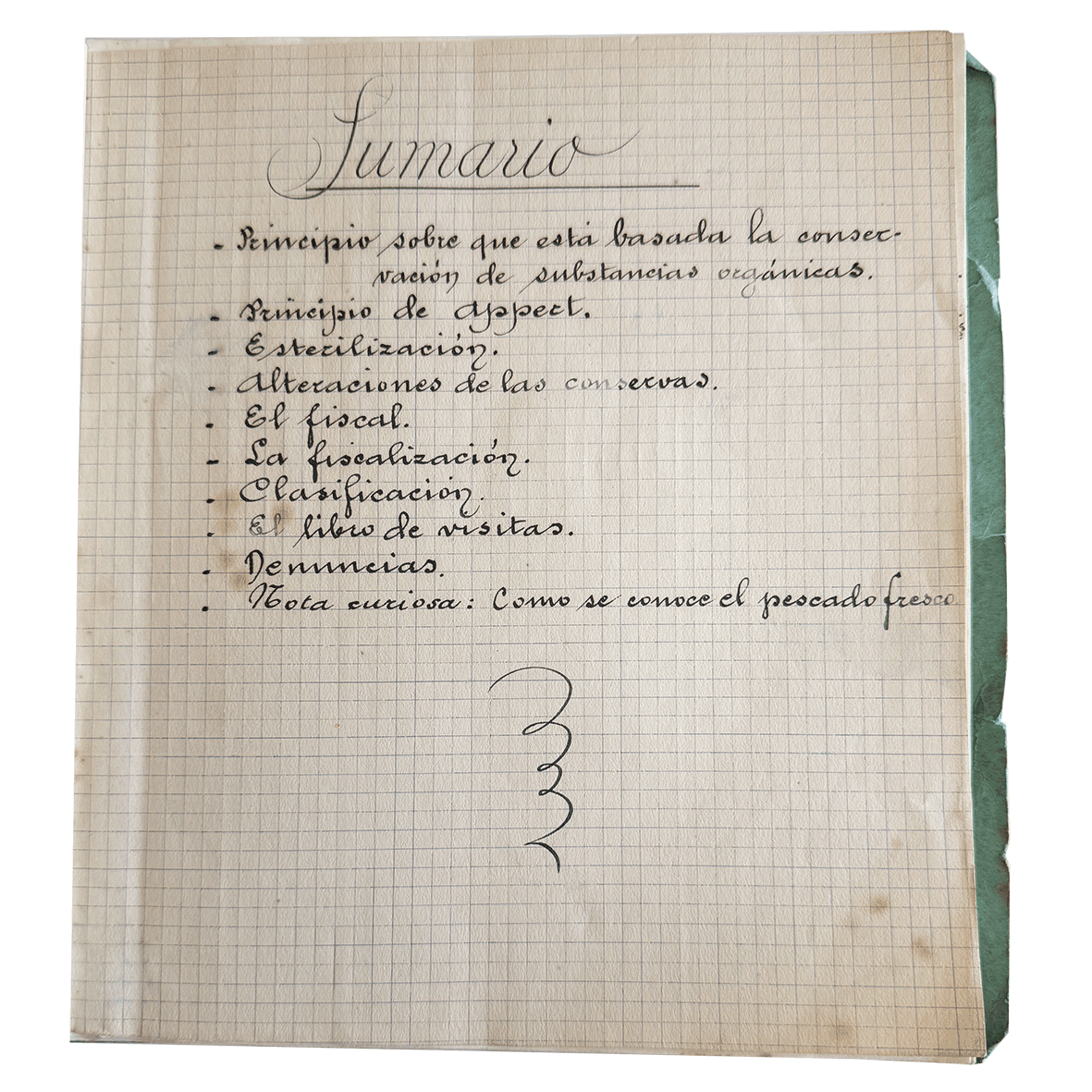
Summary
- Principle on which the preservation of organic substances is based. (Maria Ortiz)
- Appert’s principle.
- Sterilisation.
- Alterations in preserved foods. (Oliván)
- The inspector.
- Inspection procedures.
- Classification.
- The visitors’ book.
- Complaints.
- Curious note: How to recognise fresh fish. (Imanol Beleak)
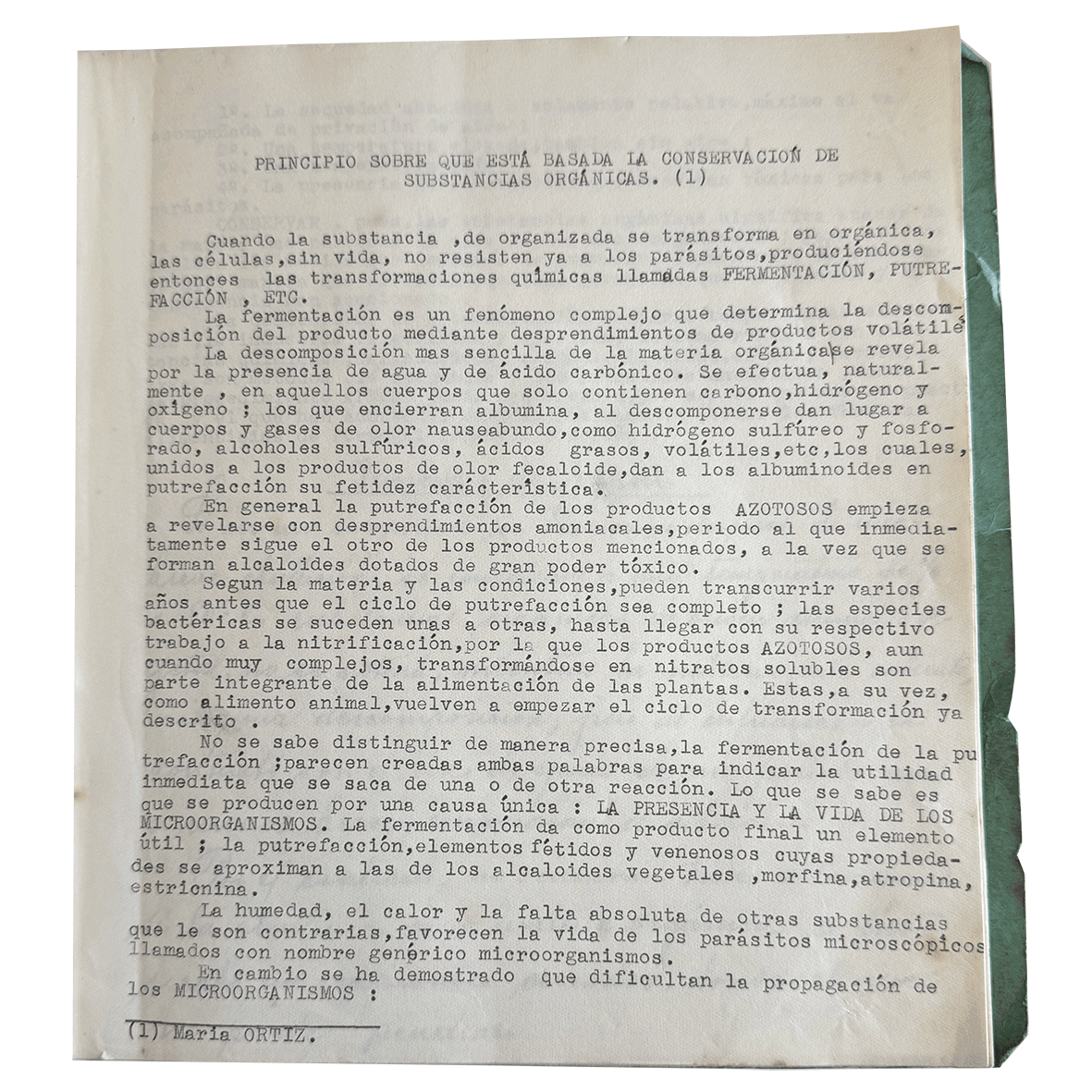
PRINCIPIO SOBRE QUE ESTÁ BASADA LA CONSERVACIÓN DE SUSTANCIAS ORGÁNICAS. (1)
Cuando la substancia, de organizada se transforma en orgánica, las células, sin vida, no resisten ya a los parásitos, produciéndose entonces las transformaciones químicas llamadas FERMENTACIÓN, PUTREFACCIÓN, ETC.
La fermentación es un fenómeno complejo que determina la descomposición del producto mediante desprendimientos de productos volátiles. En la descomposición más sencilla de la materia orgánica se revela por la presencia de agua y de ácido carbónico. Se efectúa, naturalmente, en aquellos cuerpos que solo contienen carbono, hidrógeno y oxígeno; los que contienen albúmina, al descomponerse dan lugar a cuerpos y gases de olor nauseabundo, como hidrógeno sulfuroso y fosforado, hidruros sulfurosos, ácidos grasos, volátiles, etc., los cuales, unidos a los productos de olor fecalide, dan a los albuminoides en putrefacción su fetidez característica.
En general, la putrefacción de los productos AZOTOSOS empieza a revelarse con desprendimientos amoniacales; periodos a que inmediatamente sigue el otro de los productos fétidos, a la vez que se forman alcaloides dotados de gran poder tóxico.
Según la materia y las condiciones, pueden transcurrir varios años antes que el ciclo de putrefacción se complete; las especies bacterianas se suceden unas a otras, hasta llegar con su respectivo trabajo a la nitrificación, por la que los productos AZOTOSOS, aunque muy complejos, transformados en inofensibles son parte integrante de la alimentación de las plantas. Éstas, a su vez, como alimento animal, vuelven a empezar el ciclo de transformación ya descrito.
No se sabe distinguir de manera precisa, la fermentación de la putrefacción; parecen creadas ambas palabras para indicar la utilidad inmediata que se saca de una u otra reacción. Lo que se sabe es que se producen por una causa única: LA PRESENCIA Y VIDA DE LOS MICROORGANISMOS. La fermentación da como producto final un elemento útil; la putrefacción, elementos fétidos y venenosos, cuyos productos se aproximan a los de los alcaloides vegetales: morfina, propina, estricnina.
La humedad, el calor y la falta absoluta de otras substancias que le son contrarias, favorecen la vida de los parásitos microscópicos llamados con nombre genérico microorganismos.
En cambio se ha demostrado que dificultan la propagación de los MICROORGANISMOS:
(1) María ORTIZ.
PRINCIPLE ON WHICH THE PRESERVATION OF ORGANIC SUBSTANCES IS BASED
When an organised substance transforms into organic matter, the cells, now lifeless, can no longer resist parasites, leading to chemical transformations known as FERMENTATION, PUTREFACTION, etc.
Fermentation is a complex phenomenon that results in the decomposition of the product through the release of volatile compounds. The simplest form of decomposition of organic matter occurs in the presence of water and carbonic acid. This takes place naturally in substances that only contain carbon, hydrogen, and oxygen; those containing albumin, when decomposing, release foul-smelling gases such as hydrogen sulphide and phosphorated hydrogen, sulphurous hydrides, volatile fatty acids, etc., which, combined with faecal odours, give decomposing albuminoid substances their characteristic foul smell.
In general, the putrefaction of NITROGENOUS substances begins with the release of ammonia; this stage is quickly followed by the emission of foul-smelling substances, while at the same time toxic alkaloids of considerable potency are formed.
Depending on the material and conditions, this putrefactive cycle may take several years to complete; various bacterial species follow one another, until nitrification is reached. Through this process, complex NITROGENOUS substances are eventually transformed into harmless compounds that become part of plant nutrition. These plants, in turn, serve as animal food, and the cycle of transformation begins again.
It is not easy to precisely distinguish fermentation from putrefaction; these two words seem to have been created merely to indicate the immediate usefulness derived from one reaction or the other. What is known is that both processes are caused by one common factor: THE PRESENCE AND LIFE OF MICROORGANISMS. Fermentation results in a final useful product; putrefaction, on the other hand, results in foul-smelling and poisonous elements, closely resembling vegetable alkaloids such as morphine, atropine, and strychnine.
Moisture, heat, and the absence of certain substances that counteract them encourage the life of these microscopic parasites, generally referred to as microorganisms.
Conversely, it has been demonstrated that certain conditions hinder the spread of MICROORGANISMS.
(1) María ORTIZ.
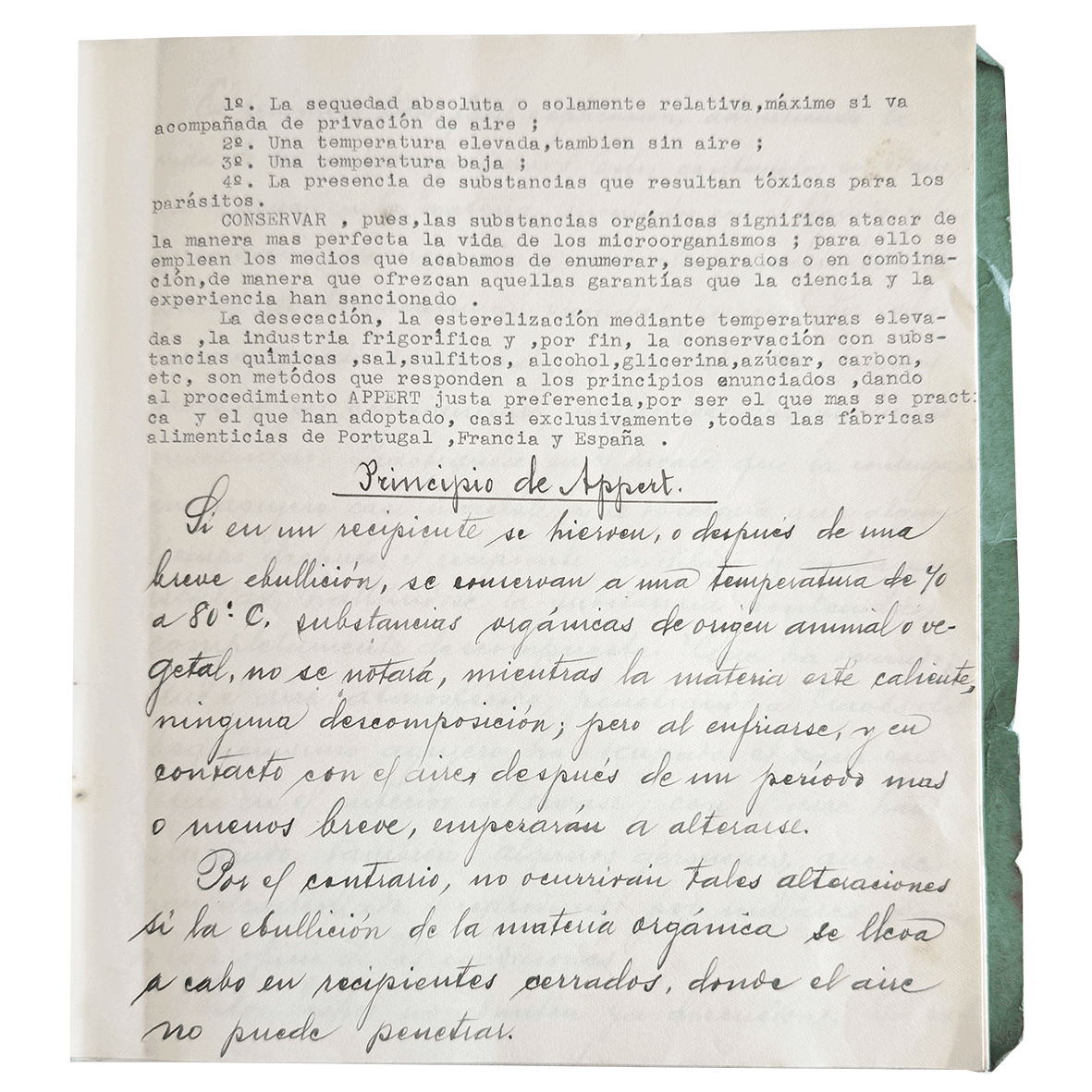
1º. La sequedad absoluta o solamente relativa, máxime si va acompañada de privación de aire;
2º. Una temperatura elevada, también sin aire;
3º. Una temperatura baja;
4º. La presencia de substancias que resultan tóxicas para los parásitos.
CONSERVAR, pues, las substancias orgánicas significa atacar de la manera más perfecta la vida de los microorganismos; para ello se emplean los medios que acabamos de enumerar, separados o en combinación, de la manera que ofrecen aquellas garantías que la ciencia y la experiencia han sancionado.
La desecación, la esterilización mediante temperaturas elevadas, la industria frigorífica y, por fin, la conservación con substancias químicas (sal, sulfitos, alcohol, éter, azúcar, carbón, etc.) son métodos que responden a los principios enunciados, dando al procedimiento APPERT justa preferencia, por ser el que más se practica y el que han adoptado, casi exclusivamente, todas las fábricas alimenticias de Portugal, Francia y España.
Principio de Appert
Si en un recipiente se hierven, o después de una breve ebullición, se conservan a una temperatura de 70 a 80 °C, substancias orgánicas de origen animal o vegetal, no se notará, mientras la materia esté caliente, ninguna descomposición; pero al enfriarse, y en contacto con el aire después de un período más o menos breve, empezarán a alterarse.
Por el contrario, no ocurrirán tales alteraciones si la ebullición de la materia orgánica se lleva a cabo en recipientes cerrados, donde el aire no puede penetrar.
1st. Absolute or even relative dryness, especially if accompanied by the absence of air;
2nd. A high temperature, also without air;
3rd. A low temperature;
4th. The presence of substances that are toxic to parasites.
To PRESERVE organic substances, therefore, means to effectively combat the life of microorganisms; to achieve this, the methods we have just enumerated are used, either separately or in combination, in the manner that science and experience have shown to be most reliable.
Desiccation, sterilisation by high temperatures, refrigeration, and finally, preservation using chemical substances (salt, sulphites, alcohol, ether, sugar, charcoal, etc.) are methods that follow these principles. The APPERT method is given rightful preference, as it is the most widely practised and has been adopted almost exclusively by food factories in Portugal, France and Spain.
Appert’s Principle
If organic substances of animal or vegetable origin are boiled in a container, or after a brief boiling are maintained at a temperature of 70 to 80 °C, no signs of decomposition will appear while the material remains hot. However, upon cooling and coming into contact with air after a certain period, they will begin to deteriorate.
On the other hand, such deterioration does not occur if the boiling of the organic material is carried out in sealed containers, where air cannot enter.
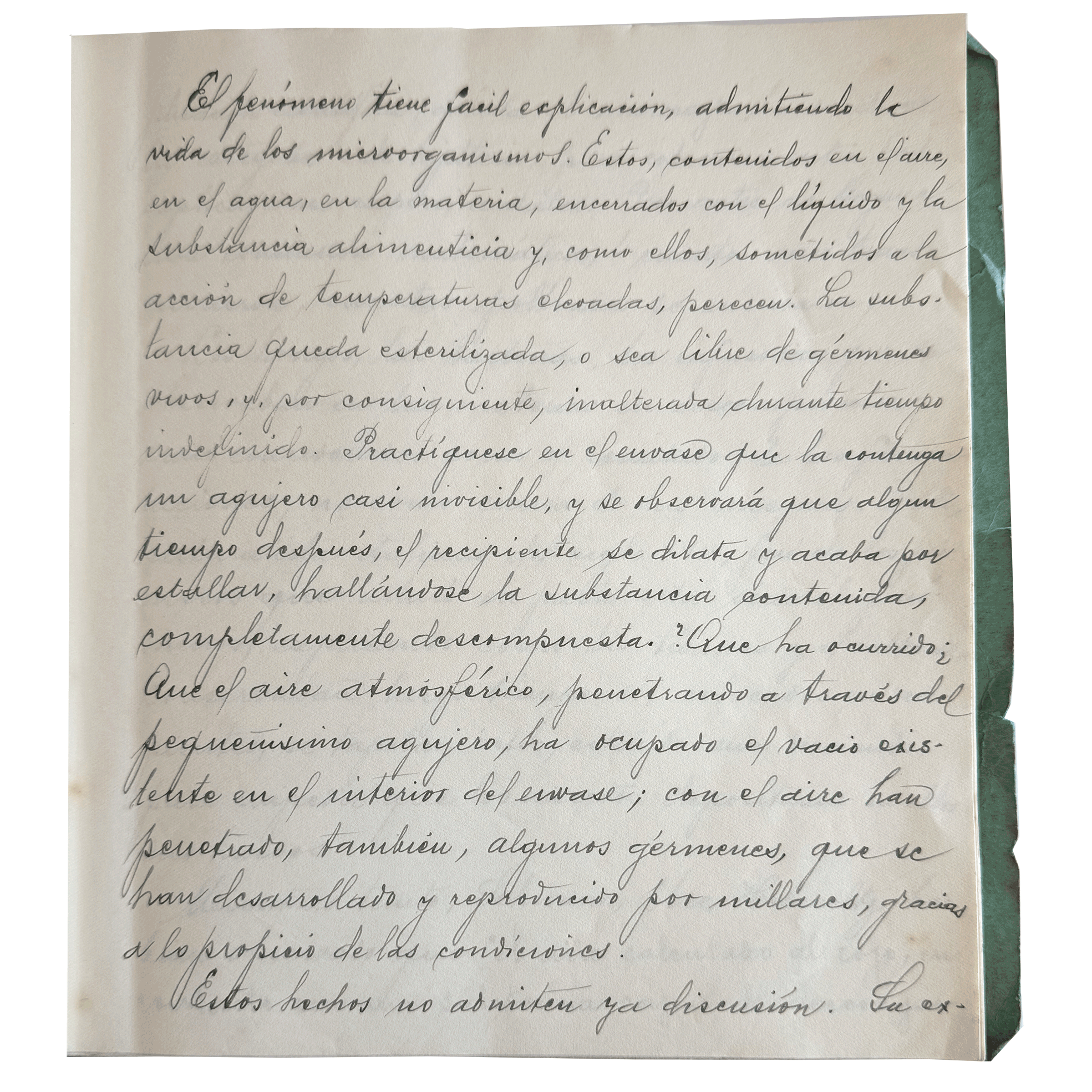
El fenómeno tiene fácil explicación, admitiendo la vida de los microorganismos. Éstos, contenidos en el aire, en el agua, en la materia, encerrados con el líquido y la substancia alimenticia y, con ellos, sometidos a la acción de temperaturas elevadas, perecen. La substancia queda esterilizada, o sea libre de gérmenes vivos y, por consiguiente, inalterada durante tiempo indefinido.
Practíquese en el envase que la contenga un agujero casi invisible, y se observará que algún tiempo después, el recipiente se dilata y acaba por estallar, hallándose la substancia contenida completamente descompuesta. ¿Qué ha ocurrido? Que el aire atmosférico, penetrando a través del pequeñísimo agujero, ha ocupado el vacío existente en el interior del envase; con el aire han penetrado, también, algunos gérmenes, que se han desarrollado y reproducido por millares, gracias a lo propio de los conservios.
Estos hechos no admiten ya discusión.
The phenomenon is easily explained by accepting the existence of microorganisms. These, present in the air, in water, and in matter itself, are enclosed along with the liquid and the food substance and, when subjected to high temperatures, perish. The substance is thus sterilised — that is, free from living germs — and consequently remains unaltered for an indefinite period.
If a nearly invisible hole is made in the container holding the substance, it will be observed that, after some time, the container expands and eventually bursts, with the contents found to be completely decomposed. What has happened? The atmospheric air, having entered through the tiny hole, has occupied the vacuum inside the container; with the air have also entered certain germs, which have multiplied and developed in great numbers, thanks to the conditions provided by the preserved substance.
These facts no longer allow for debate.
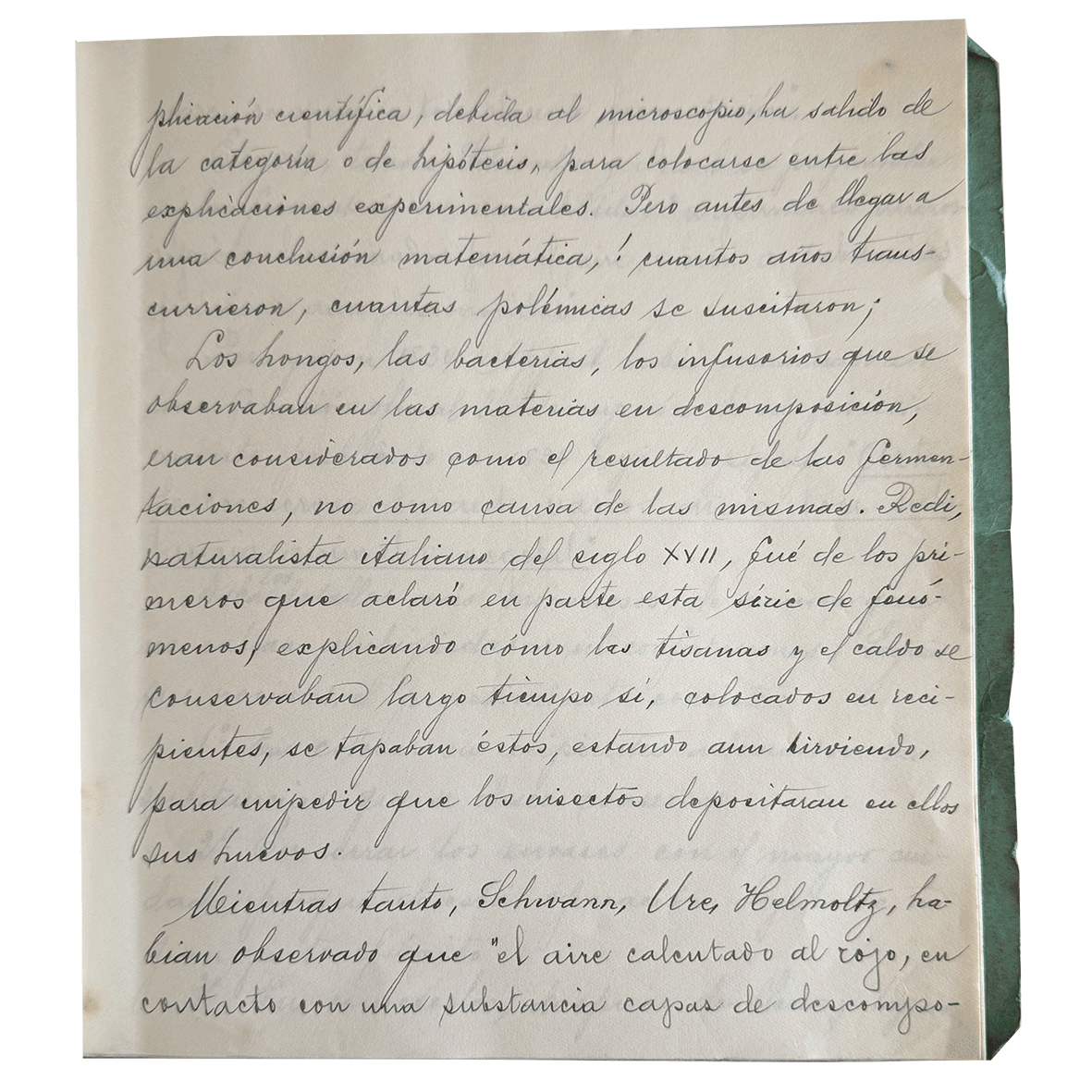
La explicación científica, debida al microscopio, ha salido de la categoría o de hipótesis, para colocarse entre las exposiciones experimentales. Pero antes de llegar a una conclusión matemática, ¡cuantos años transcurrieron, cuantas polémicas se suscitaron!
Los hongos, las bacterias, los infusorios que se observaban en las materias en descomposición, eran considerados como el resultado de las fermentaciones, no como causa de las mismas. Redi, naturalista italiano del siglo XVII, fue de los primeros que aclaró en parte esta serie de fenómenos, explicando cómo los trozos de carne se conservaban largo tiempo si, colocados en recipientes, se tapaban éstos, estando aun hirvientes, para impedir que los insectos depositaran en ellos sus huevos.
Mientras tanto, Schwann, Ure, Helmholtz, habían observado que “el aire calentado al rojo, en contacto con una substancia capaz de descomponerse a la acción de agua hirviendo en un baño de maría durante más o menos tiempo, según la naturaleza de las substancias, retribuidos cuando se juzgue oportuno.
The scientific explanation, made possible by the microscope, has moved beyond the realm of mere hypotheses to become part of experimental evidence. But before reaching a definitive conclusion, how many years went by, how many controversies were stirred!
The fungi, bacteria, and infusoria observed in decomposing matter were once considered the result of fermentation, not its cause. Redi, a 17th-century Italian naturalist, was among the first to partially clarify this series of phenomena, explaining how pieces of meat could be preserved for a long time if, after being placed in containers, these were sealed while still boiling, to prevent insects from laying their eggs in them.
Meanwhile, Schwann, Ure, and Helmholtz had observed that “air heated to red-hot, when in contact with a substance capable of decomposing under the action of boiling water in a bain-marie for more or less time depending on the nature of the substances, should be treated accordingly whenever deemed appropriate.”
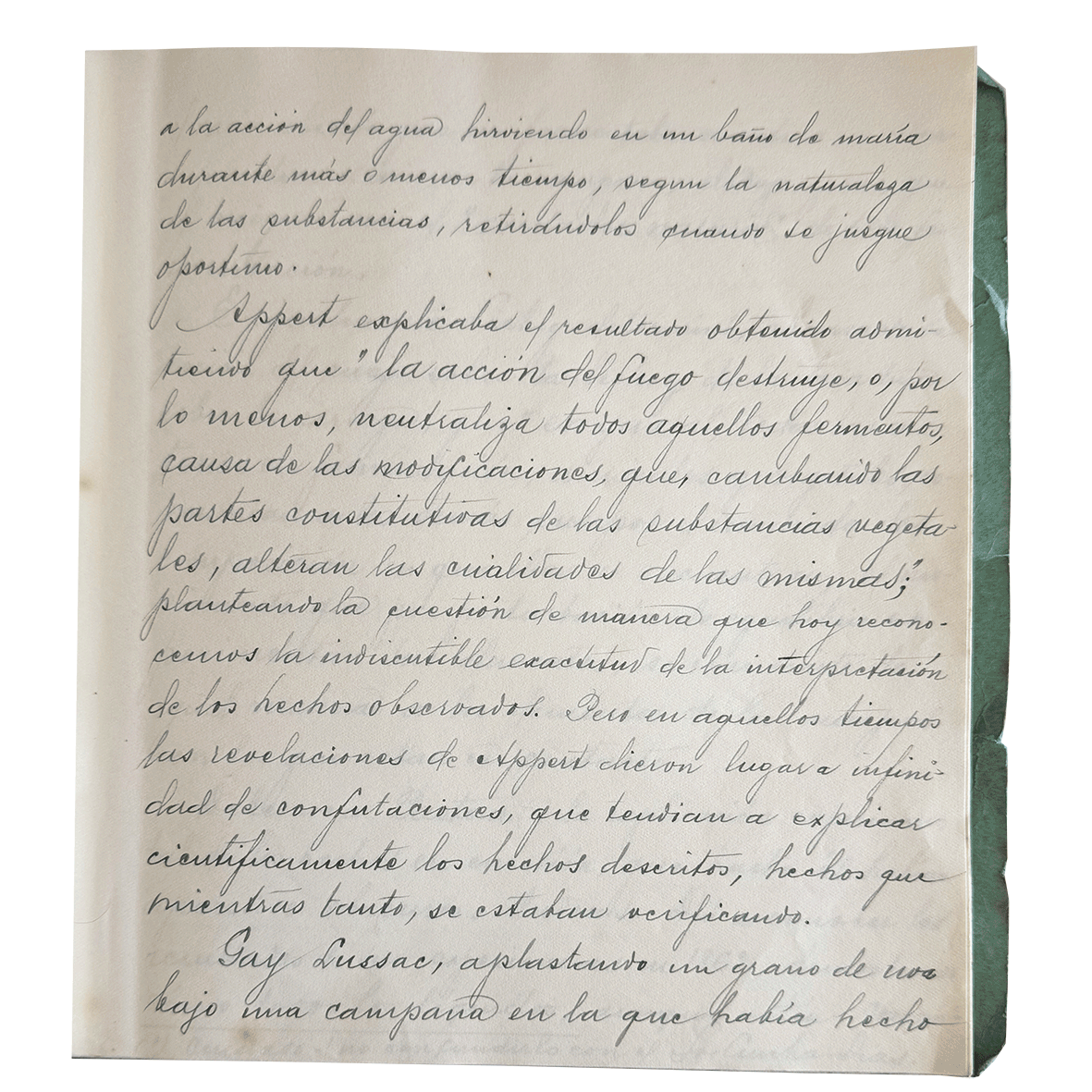
Appert explicaba el resultado obtenido admitiendo que “la acción del fuego destruye, o por lo menos, neutraliza todos aquellos elementos, causa de las modificaciones que, actuando las partes constitutivas de las substancias vegetales, alteran las cualidades de las mismas”; planteando la cuestión de manera que hoy reconocemos la inverosímil exactitud de la interpretación de los hechos observados. Pero en aquellos tiempos las revelaciones de Appert dieron lugar a infinidad de confutaciones, que llevaron a explicar científicamente los hechos descritos, hechos que mientras tanto, se estaban verificando.
Appert explained the results obtained by stating that “the action of fire destroys, or at the very least neutralises, all those elements responsible for the modifications which, acting upon the constituent parts of vegetable substances, alter their properties.” He posed the question in such a way that today we recognise the almost unbelievable accuracy of his interpretation of the observed facts. However, at the time, Appert’s revelations gave rise to countless rebuttals, which eventually led to the scientific explanation of the phenomena he described—facts that, in the meantime, were already being confirmed.
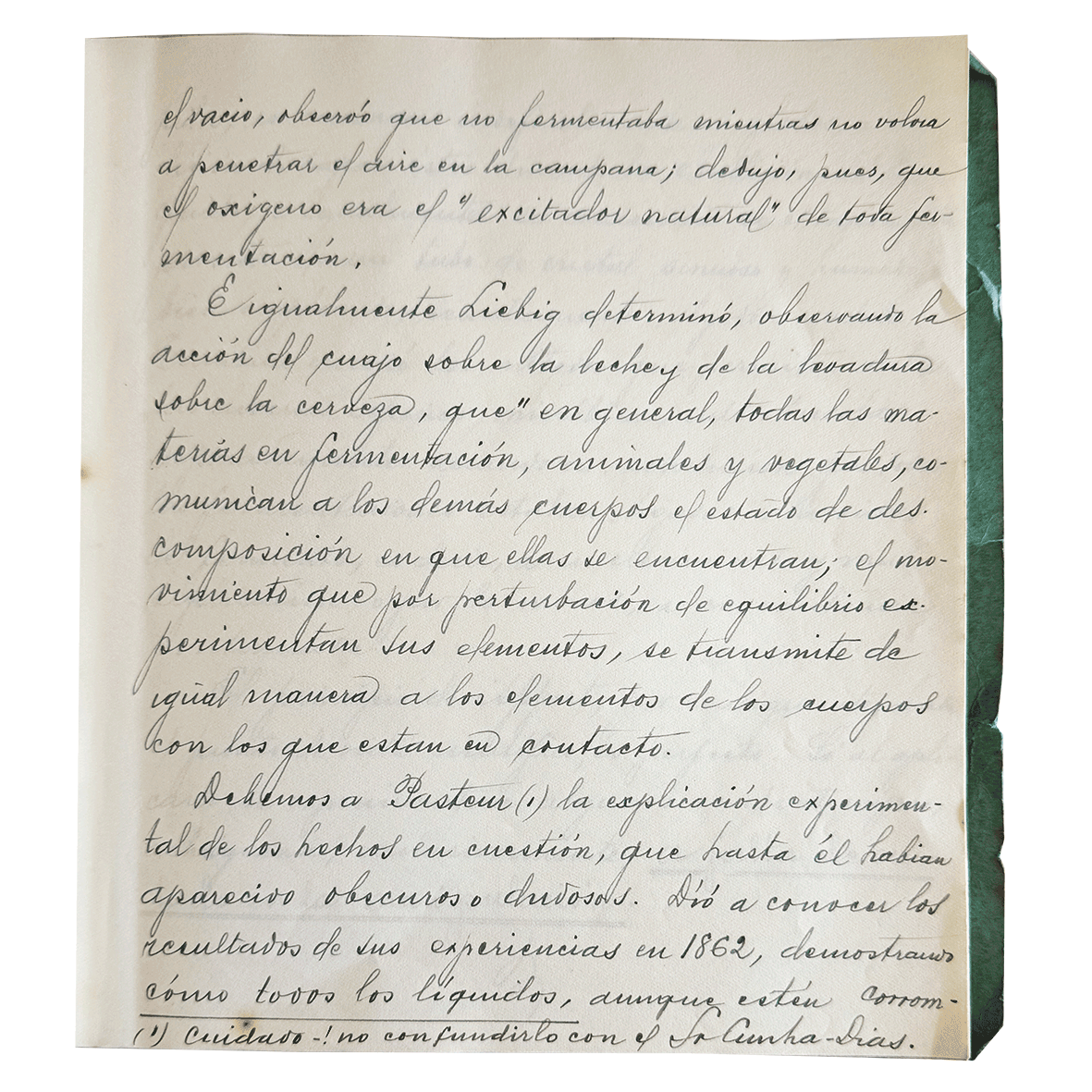
Gay Lussac, aplastando un grano de uva bajo una campana en la que había hechoel grano, observó que no fermentaba mientras no volvía a penetrar el aire en la campana; dedujo, pues, que el oxígeno era el “excitador natural” de toda fermentación.
E igualmente Liebig determinó, observando la acción del oxígeno sobre la levadura de la cerveza, que “en general, todas las materias en fermentación, animales y vegetales, comunican a los demás cuerpos el estado de descomposición en que ellas se encuentran; el movimiento que por perturbación de equilibrio experimentan sus elementos, se transmite de igual manera a los elementos de los cuerpos con los que están en contacto”.
Debemos a Pasteur(1) la explicación experimental de los hechos en cuestión, que hasta él habían aparecido oscuros y dudosos. Dio a conocer los resultados de sus experiencias en 1862, demostrando cómo todos los líquidos, aunque estén corrumpidos, se conservan indefinidamente en globos, a condición de tapar éstos durante la ebullición del líquido; e igualmente se conservan si el tapón está provisto de un tubo de cristal sinuoso y húmedo, o bien empleando, sencillamente, algodón cocido.
(1) Cuidado: no confundirlo con el Sr. Cunha-Dias.
Gay-Lussac, by crushing a grape under a bell jar in which he had removed the air, observed that it did not ferment as long as the air did not re-enter the jar. He thus deduced that oxygen was the “natural excitant” of all fermentation.
Similarly, Liebig determined — by observing the action of oxygen on beer yeast — that “in general, all fermenting substances, whether animal or vegetable, transmit to other bodies the state of decomposition in which they themselves are found; the movement caused by the disturbance of equilibrium in their elements is likewise transferred to the elements of the bodies with which they are in contact.”
We owe to Pasteur(1) the experimental explanation of the facts in question, which until his time had appeared obscure and doubtful. In 1862, he published the results of his experiments, demonstrating that all liquids, even when spoiled, can be preserved indefinitely in flasks, provided these are sealed during the boiling of the liquid; they are likewise preserved if the stopper is fitted with a moist, curved glass tube, or simply by using boiled cotton wool.
(1) Note: Not to be confused with Mr. Cunha-Dias.
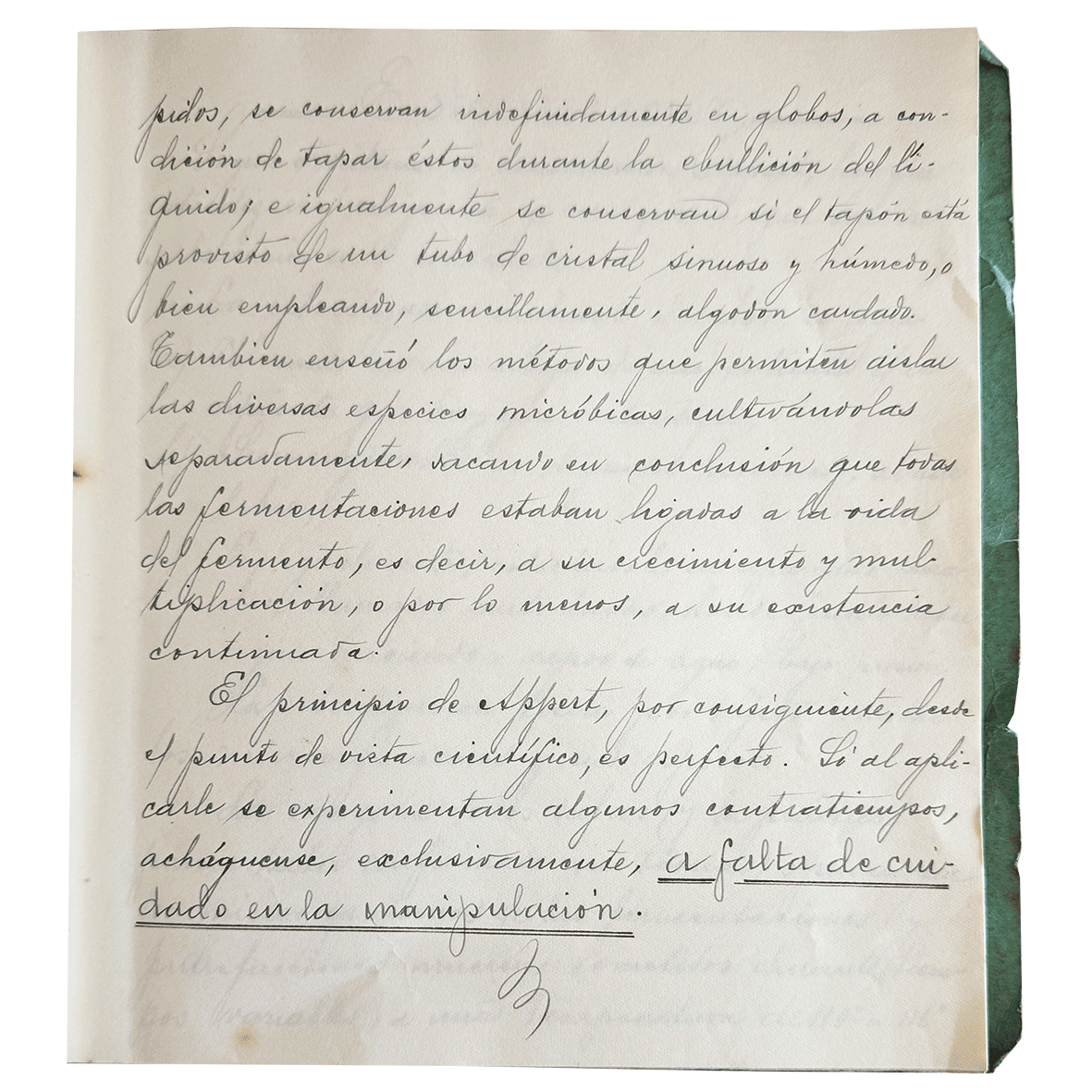
También creó los métodos que permiten aislar las diversas especies microbíicas, cultivándolas separadamente; sacando en conclusión que todas las fermentaciones estaban ligadas a la vida del fermento, es decir, a un crecimiento y multiplicación, o por lo menos, a una existencia continuada.
El principio de Appert, por consiguiente, desde el punto de vista científico, es perfecto. Si al aplicarlo se experimentan algunos contratiempos, acháquense, exclusivamente, a falta de cuidado en la manipulación.
He also devised methods that made it possible to isolate various microbial species by cultivating them separately, and concluded that all fermentations were linked to the life of the ferment — that is, to its growth and multiplication, or at the very least, to its continued existence.
Appert’s principle, therefore, from a scientific point of view, is flawless.
If, in applying it, any setbacks are encountered, they are due solely to a lack of care in handling.
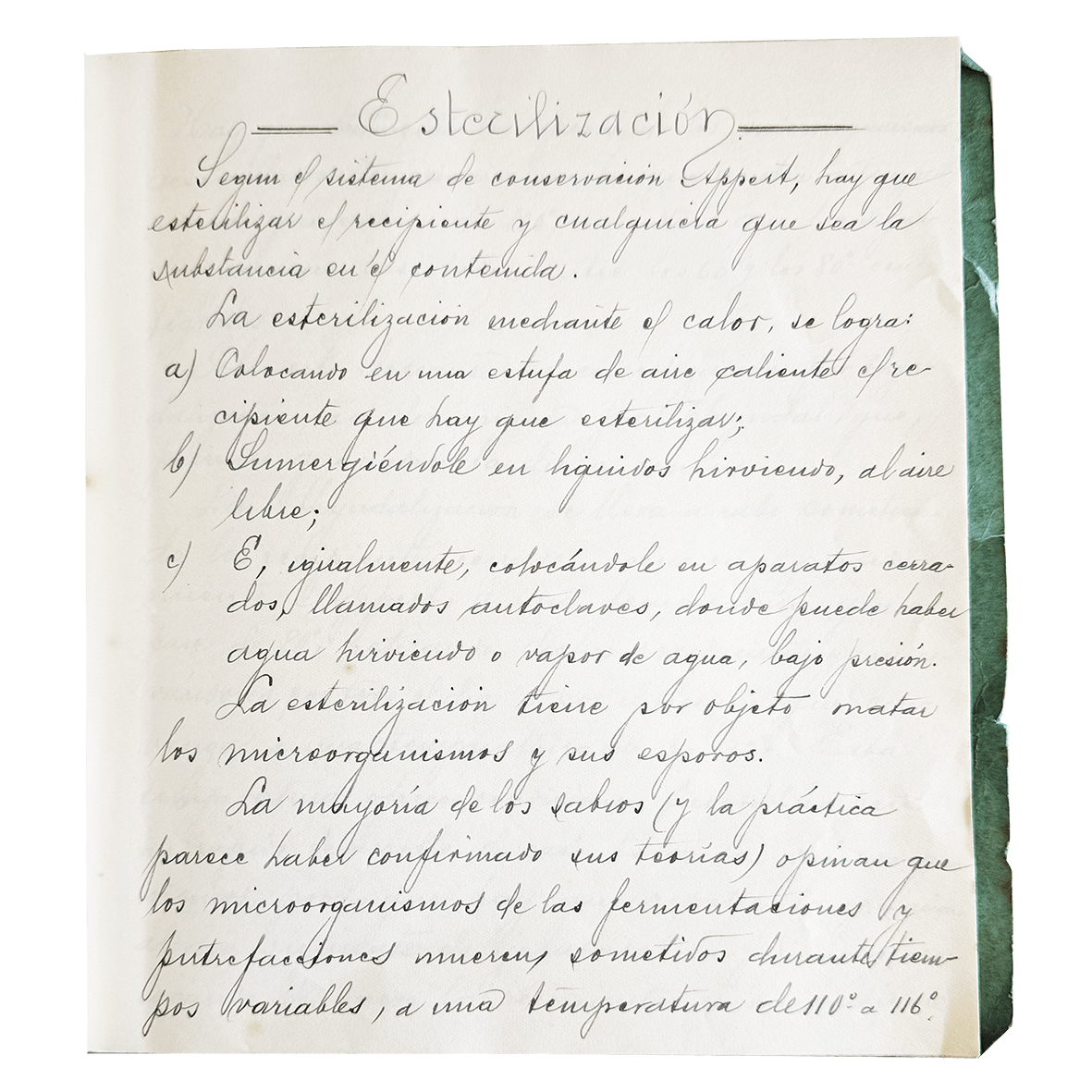
Esterilización
Según el sistema de conservación Appert, hay que esterilizar el recipiente y cualquiera que sea la substancia en él contenida.
La esterilización mediante el calor se logra:
a) Colocando en una estufa de aire caliente el recipiente que hay que esterilizar;
b) Sumergiéndolo en líquidos hirvientes, al aire libre;
c) E, igualmente, colocándolo en aparatos cerrados llamados autoclaves, donde puede haber agua hirviendo o vapor de agua, bajo presión.
La esterilización tiene por objeto matar los microorganismos y sus esporos.
La mayoría de los sabios y la práctica parece haber confirmado sus teorías: opinan que los microorganismos de las fermentaciones y putrefacciones mueren sometidos durante tiempos variables, a una temperatura de 110° a 116°.
Sterilisation
According to the Appert preservation system, the container must be sterilised, regardless of the substance it contains.
Sterilisation by heat is achieved by:
a) Placing the container to be sterilised in a hot-air oven;
b) Immersing it in boiling liquids, in open air;
c) Alternatively, placing it in sealed devices known as autoclaves, where boiling water or steam is used under pressure.
The aim of sterilisation is to kill microorganisms and their spores.
The majority of scholars — and practical experience — seem to confirm these theories: they believe that the microorganisms responsible for fermentation and putrefaction die when subjected, for varying durations, to temperatures between 110°C and 116°C.
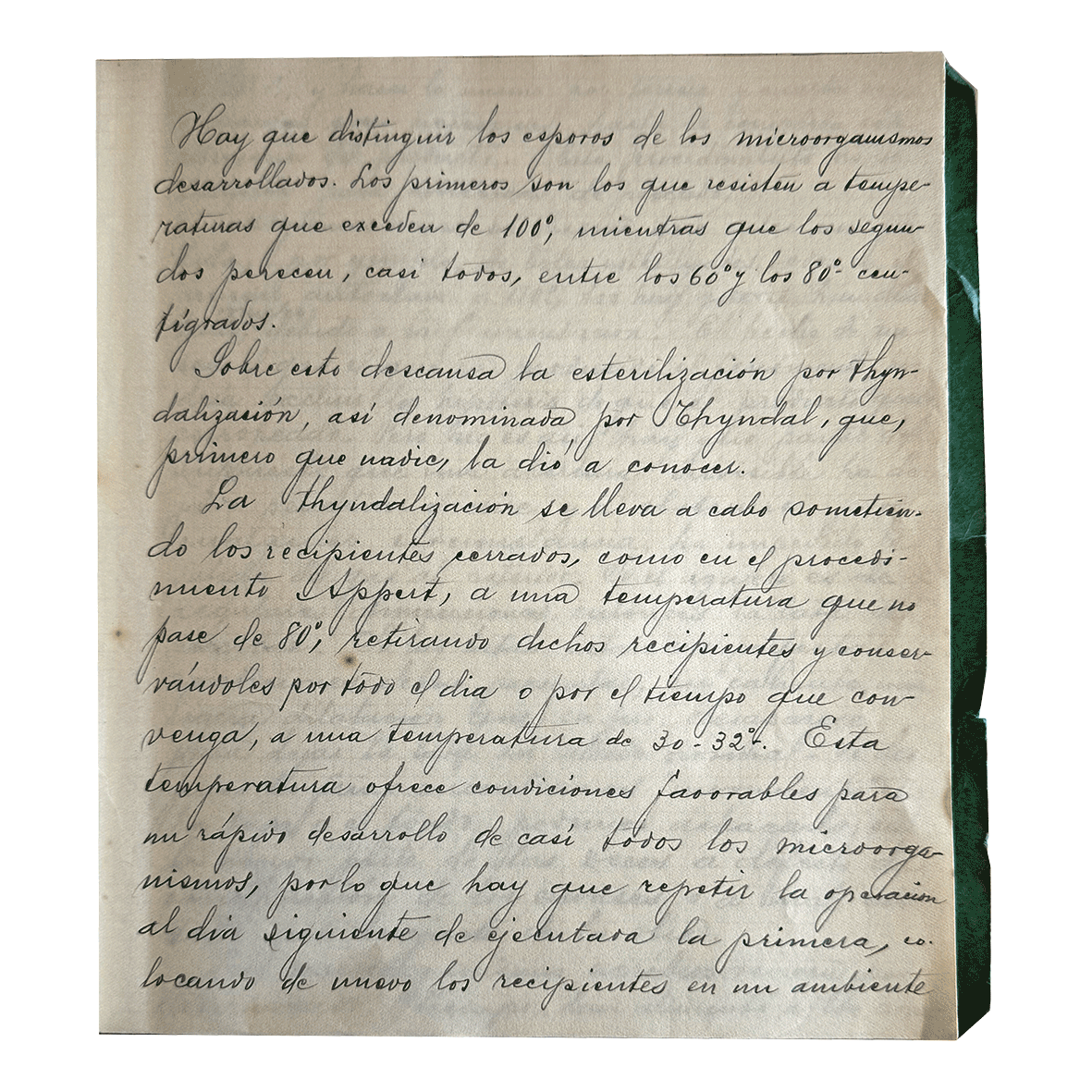
Hay que distinguir los esporos de los microorganismos desarrollados. Los primeros son los que resisten a temperaturas que exceden de 100°, mientras que los segundos perecen, casi todos, entre los 60° y los 80° centígrados.
Sobre esta doctrina la esterilización por tyndalización, así denominada por Tyndall, que, primero que nadie, la dio a conocer.
La tyndalización se lleva a cabo sometiendo los recipientes cerrados, como en el proceso Appert, a una temperatura que no pase de 80°. Retíranse dichos recipientes y consérvanse por todo el día o por el tiempo que convenga, a una temperatura de 30–32°. Esta temperatura ofrece condiciones favorables para el rápido desarrollo de casi todos los microorganismos, por lo que hay que repetir la operación al día siguiente de efectuarse la primera, colocando de nuevo los recipientes en un ambiente de 30 °C, y hacer lo mismo por tercera y cuarta vez o cuantas sean necesarias, hasta la completa esterilización del producto. Este procedimiento no se emplea para conservas de pescado.
A distinction must be made between the spores of microorganisms and the microorganisms themselves. The former are those that withstand temperatures exceeding 100°C, while the latter usually die at temperatures between 60°C and 80°C.
This distinction gave rise to tyndallisation — sterilisation so named after Tyndall, who was the first to use and introduce it.
Tyndallisation is carried out by heating sealed containers, as in the Appert process, to a temperature not exceeding 80°C. The containers are then set aside and kept for a whole day (or as long as needed) at a temperature of 30–32°C. This temperature provides ideal conditions for the rapid development of almost all microorganisms, which is why the operation must be repeated the following day after the initial heating, placing the containers once again in an environment of 30°C, and repeat the same process a third and fourth time, or as many times as necessary, until the product is fully sterilised. This method is not used for canned fish.

Algunas veces se observa que, entre una partida, y por ejemplo de latas esterilizadas sobre el mínimo autoclave a 110°, los hay que se han deteriorado (debido a la fermentación). El hecho de que sea el gas el que ha ensanchado el recipiente podría excluir la hipótesis de que el producto quede estropeado. Pero no es así; hay que admitir forzosamente que una abertura invisible ha dejado penetrar el aire y, al obstruirse luego por cualquier circunstancia, ha impedido la salida del gas al exterior. Si el agujero es de regular tamaño, entonces la lata se abomba. Si las latas están en perfectas condiciones, debe presentarse, en caliente, una ligera dilatación que, en frío, desaparece, pues deja la lata en estado normal.
Si después de frías encontramos movimiento en la tapa o el fondo, podremos achacarlo, en la mayor parte de los casos, a defectos de construcción de los envases o al mal servicio, por desajuste de la obra.
Los microorganismos aeróbicos viven por determinado tiempo, dan alimento a los anaerobios, y estos llevan a término su obra.
Sometimes it is observed that, within a batch — for example, of tins sterilised in a standard autoclave at 110°C — some have deteriorated (due to fermentation). The fact that gas has caused the container to swell could lead one to dismiss the possibility that the product itself has spoiled. But this is not the case; one must assume that an invisible opening allowed air to enter and, later, became obstructed due to some circumstance, preventing the gas from escaping. If the hole is of a moderate size, the tin will bulge. If the tins are in perfect condition, they will show a slight expansion when hot, which disappears once cold, leaving the tin in a normal state.
If, once cooled, we find movement in the lid or base, it can, in most cases, be attributed either to flaws in the construction of the containers or to poor workmanship due to mechanical misalignment.
Aerobic microorganisms survive for a certain time and serve as nourishment for the ana…
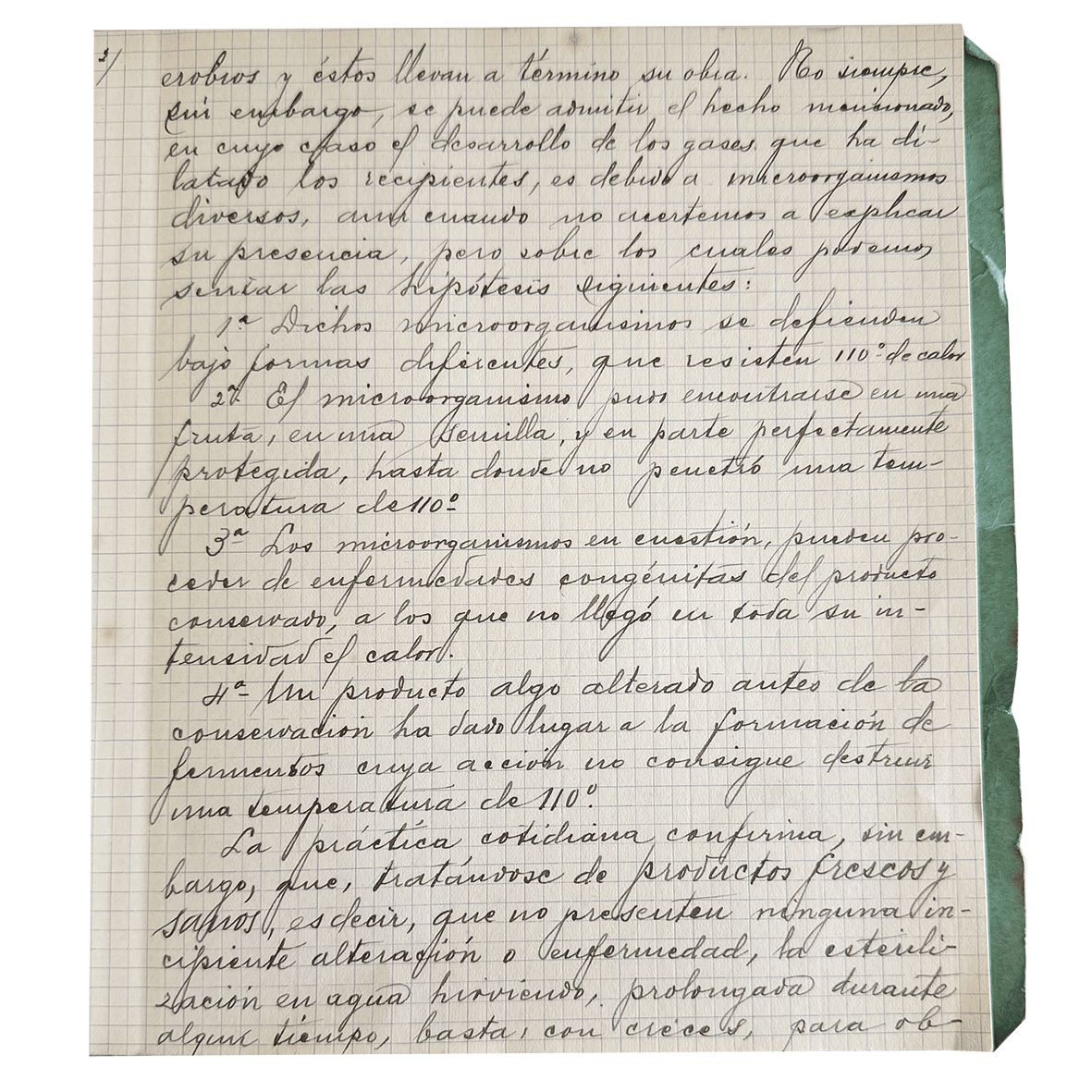
No siempre, sin embargo, se puede admitir el hecho universal en cuyo caso el desarrollo de los gases que ha dilatado los recipientes se deba a microorganismos diversos, aún cuando no cueste nada el explicar su presencia; pero sobre los cuales se formulan las hipótesis siguientes:
1ª. Debe un microorganismo en cuestión vivir bajo formas diferentes, y que resistan 110° de calor. El microorganismo fue encontrado en una fruta, en una semilla, y en parte perfectamente protegida, hasta donde no penetra una temperatura de 110°.
2ª. Los microorganismos en cuestión pueden proceder de fermentados conseguidos de productos conservados, a los que no llegó ni gota de un penetrante calor.
3ª. Un producto algo alterado antes de la conservación ha desarrollado la formación de fermentos cuya acción no consigue destruir una temperatura de 110°.
La práctica cotidiana confirma, sin embargo, que, tratándose de productos frescos y sanos, es decir, que no presenten ninguna impureza alteradora, la temperatura de esterilización en agua hirviendo, prolongada durante algún tiempo, basta con creces para obtener una buena conservación.
However, the phenomenon cannot always be universally explained by the development of gases that have caused the containers to swell, even though their presence is easily accounted for. The following hypotheses have been proposed in such cases:
1st. The microorganism in question may exist in different forms, some of which can withstand a temperature of 110°C. The microorganism was found in a fruit, in a seed, and partly in a perfectly protected area, where a temperature of 110°C could not penetrate.
2nd. The microorganisms in question may come from fermented substances derived from preserved products that were not exposed to penetrating heat.
3rd. A product that was slightly altered before preservation may have triggered the formation of ferments whose activity is not destroyed by a temperature of 110°C.
Everyday practice confirms, however, that in the case of fresh and sound products — that is, those showing no signs of spoilage — boiling water sterilisation, when maintained for a sufficient period, is more than adequate to ensure good preservation.
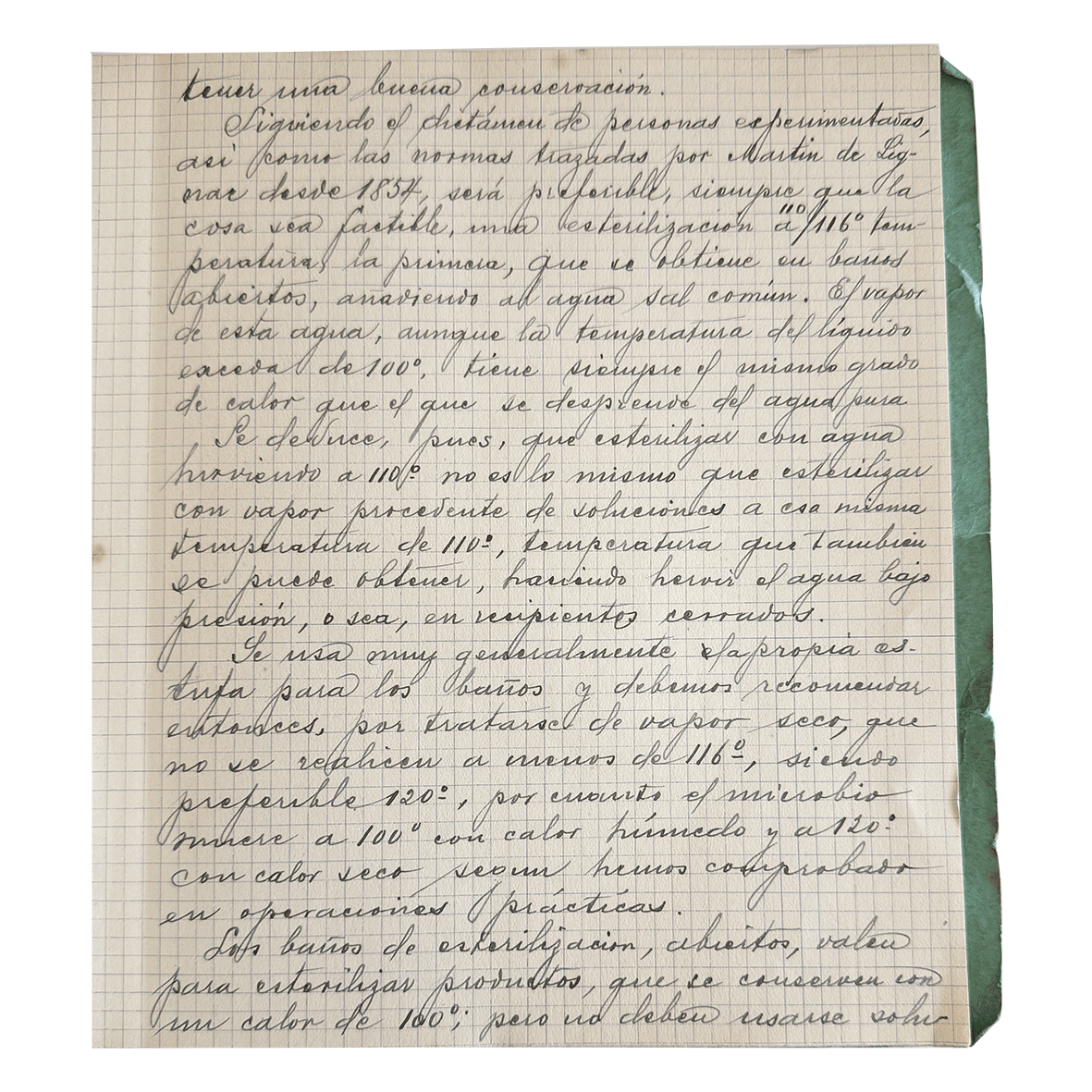
Siguiendo el dictamen de personas experimentadas (como las normas fijadas por Martín de Lignac desde 1875), será preferible, aunque se trabaje con más gasto, la esterilización a 116° como tomando la primera que se obtiene con baños abiertos, análogos al agua del común. El vapor de esta agua, aunque la temperatura del líquido pase de 100°, tiene siempre el mismo grado de calor que el que se desprende del agua.
Se deduce, pues, que esterilizar con agua hirviendo a 110° no es lo mismo que esterilizar con vapor procedente de soluciones a esa misma temperatura de 110°. La temperatura que también se puede obtener haciendo hervir agua bajo presión, o sea, en recipientes cerrados.
Se usa muy generalmente la prueba con tinta para los tubos y obtener nuevamente resultados, sin tratarse de vapor seco que no se realiza a menos de 116°, siendo preferible 120°; por cuanto, el intervalo entre a 100° un calor primero a 110°, con calor seco, será menos confirmado en organismos prácticos.
Los baños de esterilización abiertos valen para esterilizar productos que se cuecen con un calor de 100°; pero no deben usarse sob ciertos alimentos en envases metálicos, aunque estén barnizados, porque se perjudicaría una presentación.
According to the opinion of experienced individuals (such as the guidelines established by Martin de Lignac since 1875), sterilisation at 116°C is preferable, even if it involves higher costs. This is considered the minimum level achieved through open baths, similar to ordinary water. The steam from this water, even if the temperature of the liquid exceeds 100°C, always maintains the same degree of heat as the water from which it is released.
It follows, then, that sterilising with boiling water at 110°C is not the same as sterilising with steam from solutions at the same temperature. This temperature can also be achieved by boiling water under pressure — that is, in sealed containers.
The test using dye in tubes is commonly used to confirm the results, although it does not account for dry steam, which cannot be produced below 116°C, with 120°C being preferable. The interval between 100°C and a dry heat of 110°C is, therefore, less reliable in eliminating practical microorganisms.
Open sterilisation baths are suitable for sterilising products that are cooked at 100°C, but should not be used for certain foods in metal containers, even if varnished, because it would impair their presentation.
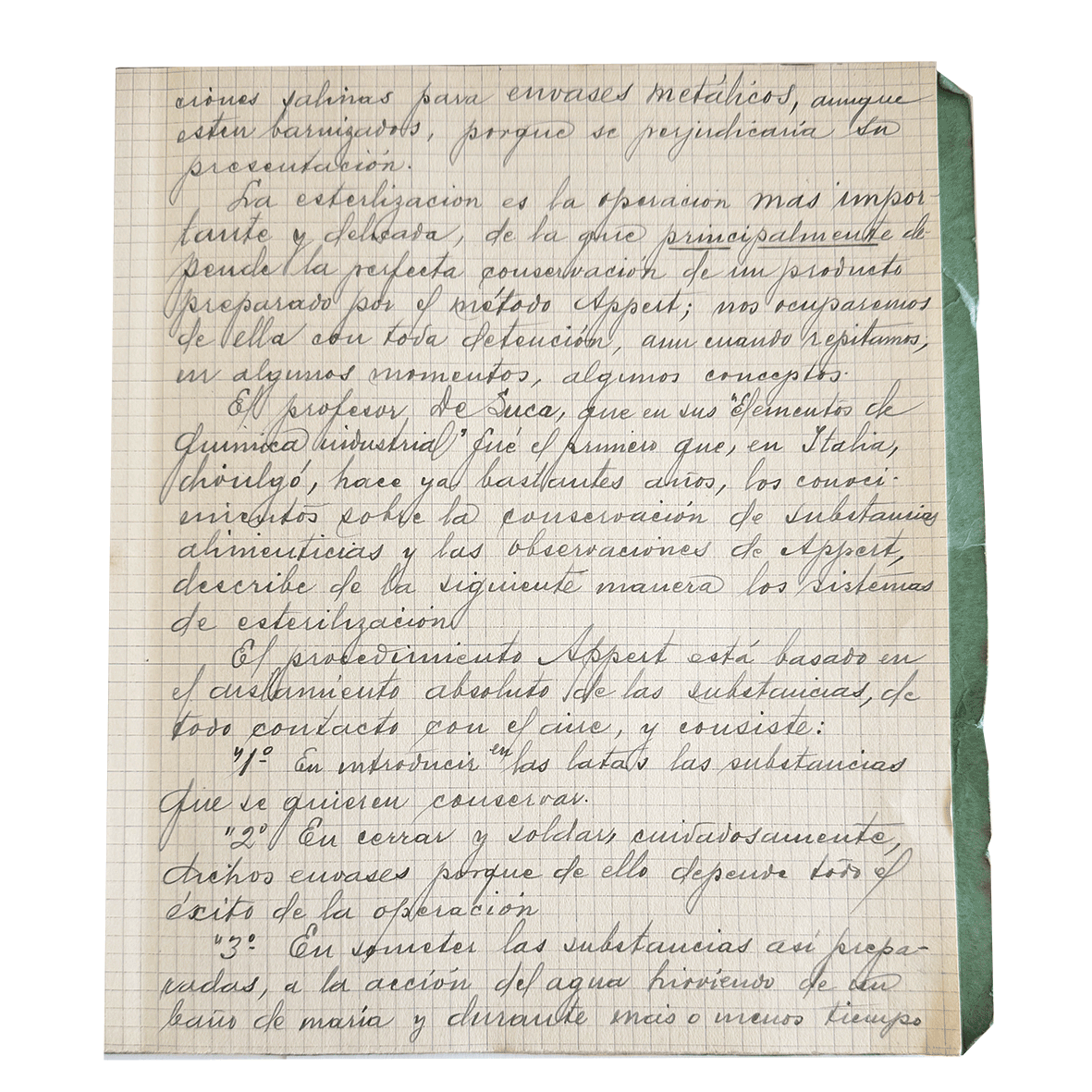
La esterilización es la operación más importante y delicada de la fase, principalmente de donde resulta la recta conservación de un producto preparado por el proceso Appert. No ocuparemos de ella con toda detención, aun cuando repitamos en algunos momentos algunos conceptos.
El profesor De Luca, que es un elemento de química industrial y el primero que en Italia privilegió, hace ya bastantes años, los conocimientos sobre la conservación de substancias alimenticias y las observaciones de Appert, describe de la siguiente manera los sistemas de esterilización:
El procedimiento Appert está basado en el cuidadosamente observado de la exclusión de los productos con el aire, y consiste:
1º en introducir en las latas las substancias que se quieren conservar.
2º en cerrar y soldar cuidadosamente dichos envases porque de ello depende todo el éxito de la operación.
3º en someter las substancias así preparadas a la acción del agua hirviendo de un baño de maría y durante más o menos tiempo según lo requiera la naturaleza de las mismas y el tamaño del envase.
Sterilisation is the most important and delicate operation of the process, primarily because the proper preservation of a product prepared using the Appert method depends on it. We shall focus on it in detail, even if some concepts are repeated along the way.
Professor De Luca, an industrial chemist and one of the first in Italy to champion the knowledge of food preservation and the findings of Appert, describes the methods of sterilisation as follows:
The Appert method is based on the carefully observed principle of excluding air from the products, and it consists of:
1st — placing the substances to be preserved into tins;
2nd — carefully sealing and soldering the containers, as the success of the entire operation depends on this step;
3rd — subjecting the prepared substances to the action of boiling water in a bain-marie for a more or less extended period according to the nature of the contents and the size of the container.
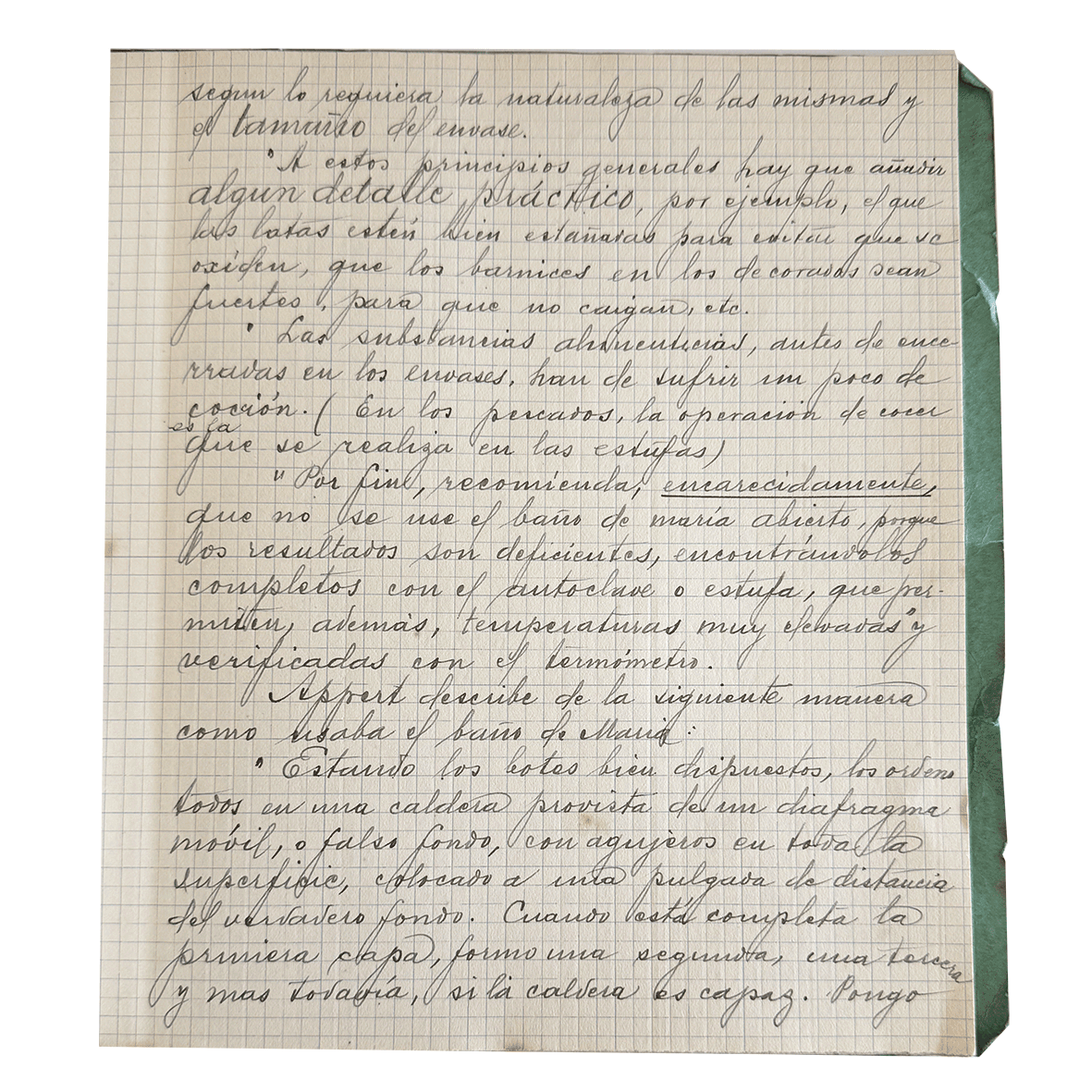
A estos principios generales hay que añadir algún detalle práctico, por ejemplo, que las latas deben bien estañadas para evitar que se oxiden, que los remaches de los de corvos sean fuertes, y para que no caigan, etc.
Las substancias alimenticias, antes de ser recueltas en los envases, han de sufrir un proceso de cocción. En lo necesario la operación de cocción que se practica en las estufas.
Por fin, recomienda encarecidamente que no se use el baño de maría abierto: los resultados son deficientes, eventualmente incompletos con sustancias sólidas que retienen, además, temperaturas muy elevadas y verificadas con el termómetro.
Appert describe de la siguiente manera cómo instaló el baño de maría:
“Estando los botes bien fabricados, los coloco en una caldera provista de un diafragma móvil, o falso fondo, (con agujeros en toda la superficie, elevado a unas pulgadas de distancia del verdadero fondo. Cuando está completa la primera capa, formo una segunda en una cruz (y más si basta, si la caldera es capaz).
To these general principles, some practical details must be added — for example, that tins must be well tinned to prevent oxidation, that the rivets and seams of curved surfaces must be strong to prevent them from falling apart, etc.
Food substances, before being sealed in containers, must undergo a cooking process. Where necessary, this cooking is done in ovens.
Finally, it is strongly recommended not to use an open bain-marie: the results are often poor and incomplete, especially with solid substances that retain excessive heat, which should be carefully monitored with a thermometer.
Appert describes the setup of his bain-marie as follows:
“Once the tins are properly made, I place them in a boiler fitted with a movable diaphragm, or false bottom (with holes across its entire surface), raised a few inches above the true base. Once the first layer is in place, I arrange a second one crosswise (and more if needed, depending on the capacity of the boiler).
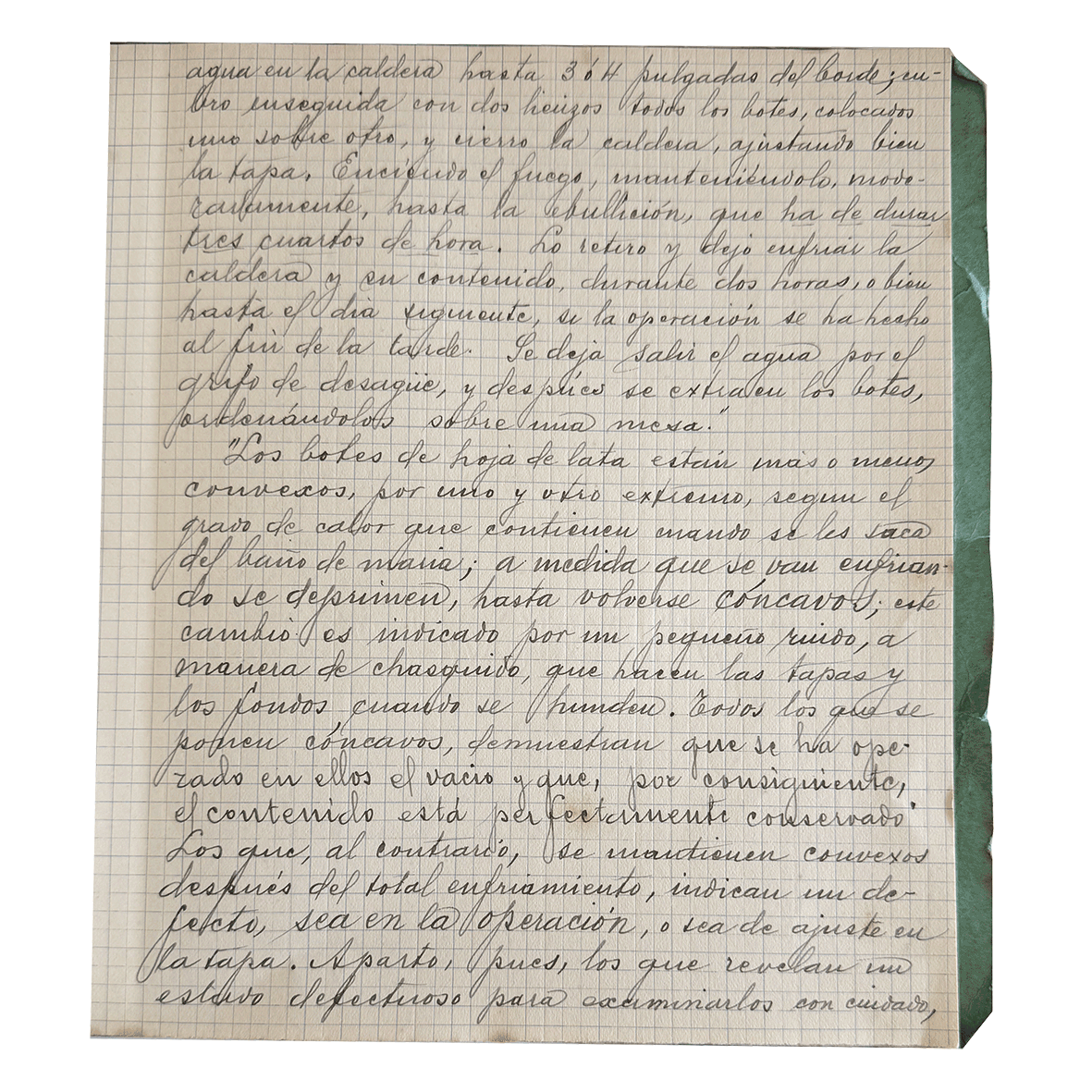
Pongo agua en la caldera hasta 3 ½ pulgadas del borde, y un hierro enrejado con dos hierros donde los botes, colocados uno sobre otro, vieran la caldera ajustándose la tapadera. Encendido el fuego, inmediatamente lo retiro cuidadosamente, hasta la ebullición que ha de durar tres cuartos de hora. Lo cierro. Dejo enfriar la caldera en su momento, durante dos horas o bien hasta otra remesa, si la operación se hace al fin de la tarde. Se deja salir el agua por el tubo de desagüe, y después se extraen los botes, colocándolos sobre una mesa.
Los botes de hoja de lata están más o menos convexos, con uno o más extremos resumiendo el paso de calor que contiene aún a los vasos del baño de maría; a medida que se van enfriando, se deprimen hasta volverse cóncavos, este cambio es mirado por los operarios como la manera de chequeo que hacen las tapas y los fondos, cuando se hunden. Todos los que se ponen llanos, se muestra que se ha agotado en ellos el vacío interior, y, por consiguiente, el contenido está ciertamente conservado.
Los que, al contrario, se mantienen convexos después del total enfriamiento, indican un defecto, sea en la operación, o sea de ajuste en la tapa. Apártese, pues, los que revelan un estado sospechoso para examinarlos con cuidado, dos o tres dias después, ocurriendo as vezes que hay que ferver totalmente el contenido.
I then place water in the boiler up to 3½ inches from the rim, and a grate with two bars where the tins are stacked one on top of another inside the boiler, with the lid tightly sealed. Once the fire is lit, it is closely monitored until boiling begins, which should be maintained for three-quarters of an hour. Then, the fire is put out. The boiler is left to cool for a while, for two hours or until the next batch, if the operation takes place in the late afternoon. The water is drained through the outlet pipe, and the tins are then removed and placed on a table.
The tinplate containers are more or less convex, with one or more ends showing the effect of retained heat from the bain-marie. As they cool down, they become depressed until they turn concave. This change is regarded by workers as a sign — a way of checking — that the lids and bottoms have properly sealed.
All tins that flatten indicate that the vacuum inside has been successfully formed and, therefore, the contents are safely preserved.
Those that, on the contrary, remain convex after complete cooling indicate a fault — either in the sterilisation process or in the sealing of the lid. Such tins should therefore be set aside for careful inspection, two or three days later, as it sometimes happens that the entire contents must be reboiled.
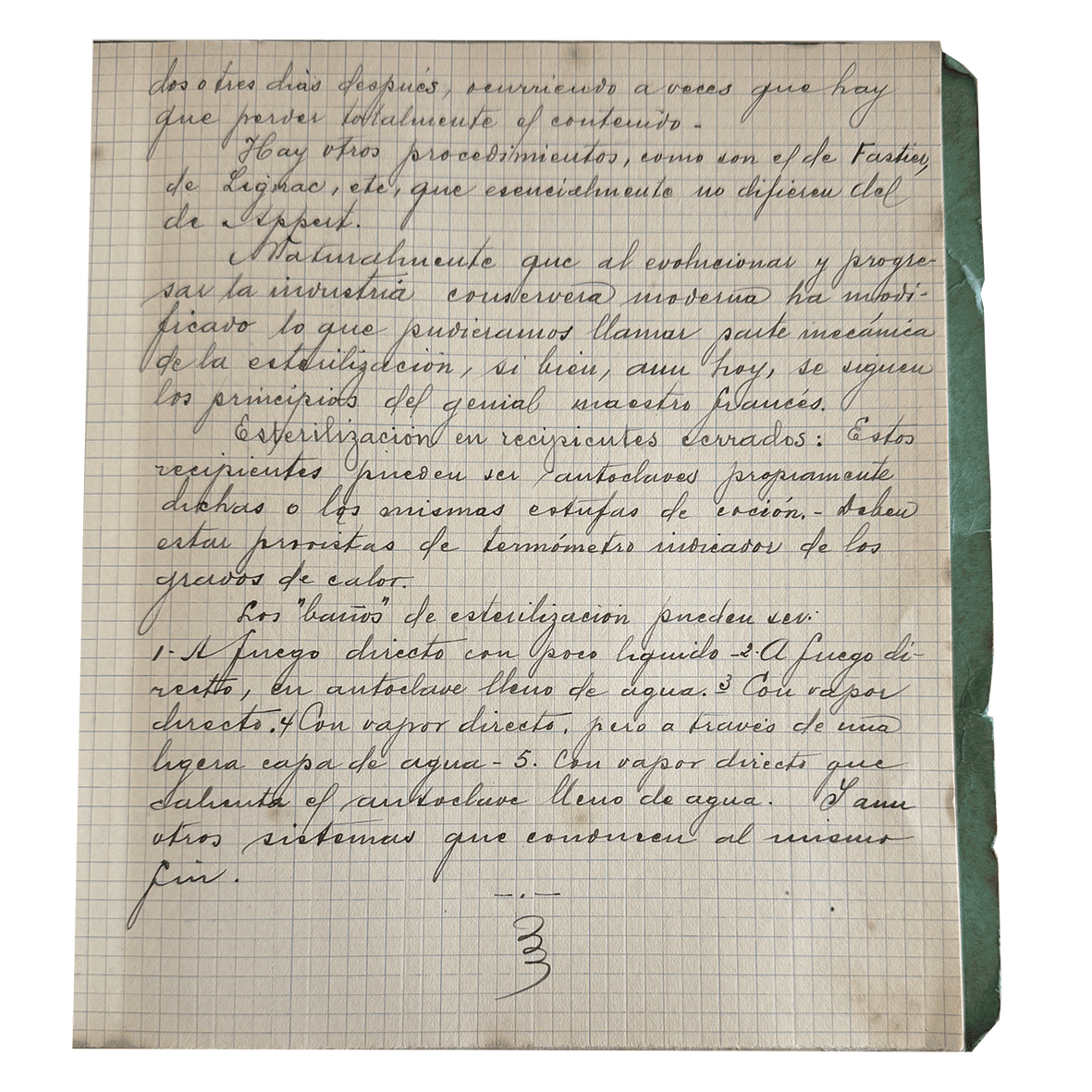
Hay otros procedimientos, como un tal Fastier de Lignac, este que esencialmente no difiere del de Appert.
Naturalmente que al evolucionar y progresar la industria, la conservación moderna ha modificado lo que publicamos. Llamar puede mecánica esta esterilización, si bien aún hoy se siguen los principios del genial inventor francés.
Esterilización en recipientes cerrados: Estos recipientes pueden ser autoclaves expresamente hechos o las mismas estufas de cocción. Deben estar provistos de termómetros indicadores de los grados de calor.
Los baños de esterilización pueden ser:
- A fuego directo con poco líquido.
- A fuego directo en autoclave lleno de agua.
- Con vapor directo.
- Con vapor directo, pero a través de una ligera capa de agua.
- Con vapor directo que calienta el autoclave lleno de agua.
Y aun otros sistemas que conllevan al mismo fin.
There are other methods, such as the so-called Fastier de Lignac, which essentially does not differ from Appert’s.
Naturally, as preservation techniques have evolved, modern procedures have modified what we have described. Some call this improved method “mechanical sterilisation,” but it is still based on the same principles originally established by Appert.
Sterilisation in sealed containers: These containers may be autoclaves specially built for this purpose or the same cooking ovens, as long as they are fitted with thermometers to monitor the temperature.
Sterilisation baths may include:
- Direct flame with the container fully immersed in liquid.
- Direct flame with an autoclave filled with water.
- With direct steam.
- With direct steam passing through a thin layer of water.
- With direct steam in an autoclave filled with water.
And other similar systems that serve the same purpose.
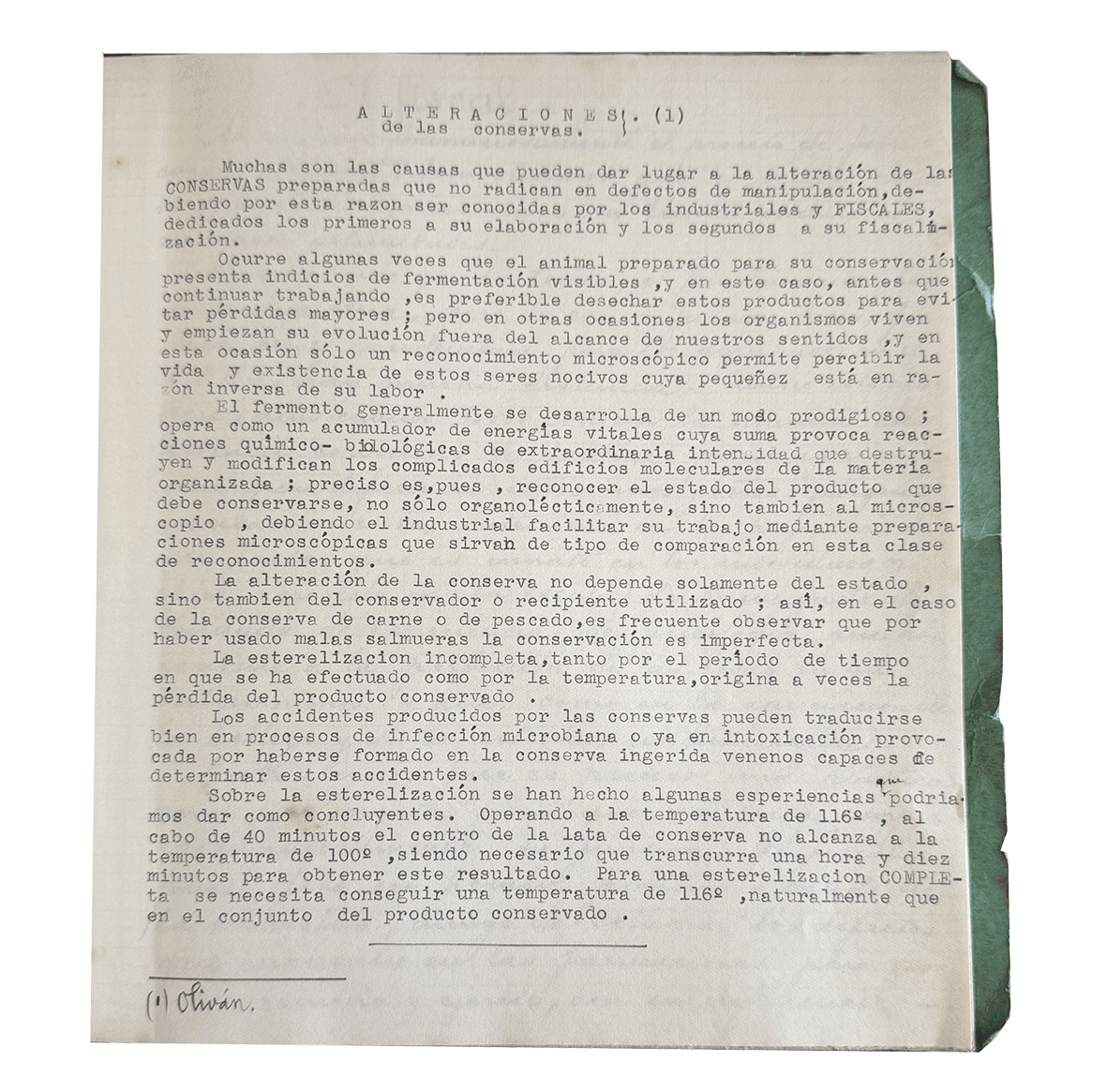
ALTERACIONES de las CONSERVAS (1)
Muchas son las causas que pueden dar lugar a la alteración de las CONSERVAS preparadas que no radican en defectos de manipulación, debiendo por esta razón ser conocidas por los industriales y FISCALES, dedicados los primeros a su elaboración y los segundos a su fiscalización.
Ocurre algunas veces que el animal preparado para su conservación presenta indicios de fermentación visibles, y en este caso, antes que continuar trabajándolo, es preferible desechar estos productos para evitar pérdidas mayores; pero en otras ocasiones los organismos viven y empiezan su evolución fuera del alcance de nuestros sentidos y en tales casos sólo un reconocimiento microscópico permite percibir la vida y existencia de estos seres nocivos cuya pequeñez está en razón inversa de su labor.
El fermento generalmente se desarrolla de un modo insidioso: opera como un acumulador de energías vitales cuya suma provoca reacciones químico-biológicas de considerable intensidad, que desintegran y modifican los complicados edificios moleculares de la materia organizada; preciso es, pues, reconocer el estado del producto que debe conservarse, no sólo organolépticamente, sino también al microscopio, debiendo el industrial facilitar su trabajo mediante preparaciones microscópicas que sirvan de tipo de comparación en esta clase de reconocimientos.
La alteración de la conserva no depende solamente del estado, sino también del conservador o recipiente utilizado; así, en el caso de la conserva de carne o de pescados, es frecuente observar que por haber usado malas salmueras la conservación es imperfecta.
La esterilización incompleta, tanto por el período de tiempo en que se ha efectuado como por la temperatura, origina a veces la pérdida del producto conservado.
Los accidentes producidos por las conservas pueden traducirse bien en procesos de infección microbiana o ya en intoxicación provocada por haberse formado en la conserva ingerida venenos capaces de determinar estas consecuencias.
Sobre la esterilización se han hecho algunas experiencias “podríamos decir” demoledoras y concluyentes. Operando a la temperatura de 116°, al cabo de 40 minutos el centro de la lata de conserva no alcanza a la temperatura de 100°, siendo necesario que transcurra una hora y diez minutos para obtener este resultado. Para una esterilización COMPLETA se necesita conseguir una temperatura de 116°, naturalmente que en el conjunto del producto conservado.
(1) Oliván
ALTERATIONS in PRESERVED FOODS (1)
There are many causes that may lead to the alteration of preserved foods which do not stem from handling errors. For this reason, they must be understood by both manufacturers and INSPECTORS — the former responsible for their production, and the latter for their regulation.
Sometimes, the animal prepared for preservation shows visible signs of fermentation, and in such cases, before continuing to process it, it is preferable to discard these products to avoid greater losses. However, at other times, organisms are alive and begin to evolve beyond the reach of our senses, and in such cases, only microscopic analysis can reveal the life and presence of these harmful beings, whose small size is inversely proportional to their destructive effect.
Fermentation generally develops insidiously: it acts as an accumulator of vital energies whose sum triggers chemical-biological reactions of considerable intensity, breaking down and altering the complex molecular structures of organised matter. It is therefore necessary to assess the condition of the product to be preserved — not only organoleptically, but also under the microscope — and the manufacturer must assist this process by preparing microscopic samples that serve as reference points in this type of examination.
The alteration of preserved foods depends not only on the condition of the product itself but also on the preservative or container used. In the case of preserved meat or fish, it is often observed that poor-quality brines result in imperfect preservation.
Incomplete sterilisation — whether due to insufficient time or inadequate temperature — can sometimes lead to the loss of the preserved product.
Incidents involving preserved foods may result in microbial infections or even poisoning, caused by toxins formed within the preserved food itself — toxins capable of producing severe consequences.
With regard to sterilisation, some experiments have been carried out that we might call decisive and conclusive. When operating at a temperature of 116°C, after 40 minutes, the centre of a tin of preserved food does not reach 100°C; it takes one hour and ten minutes to reach this temperature. For COMPLETE sterilisation, it is essential to achieve a temperature of 116°C — and crucially, this must be throughout the entire product mass.
(1) Oliván
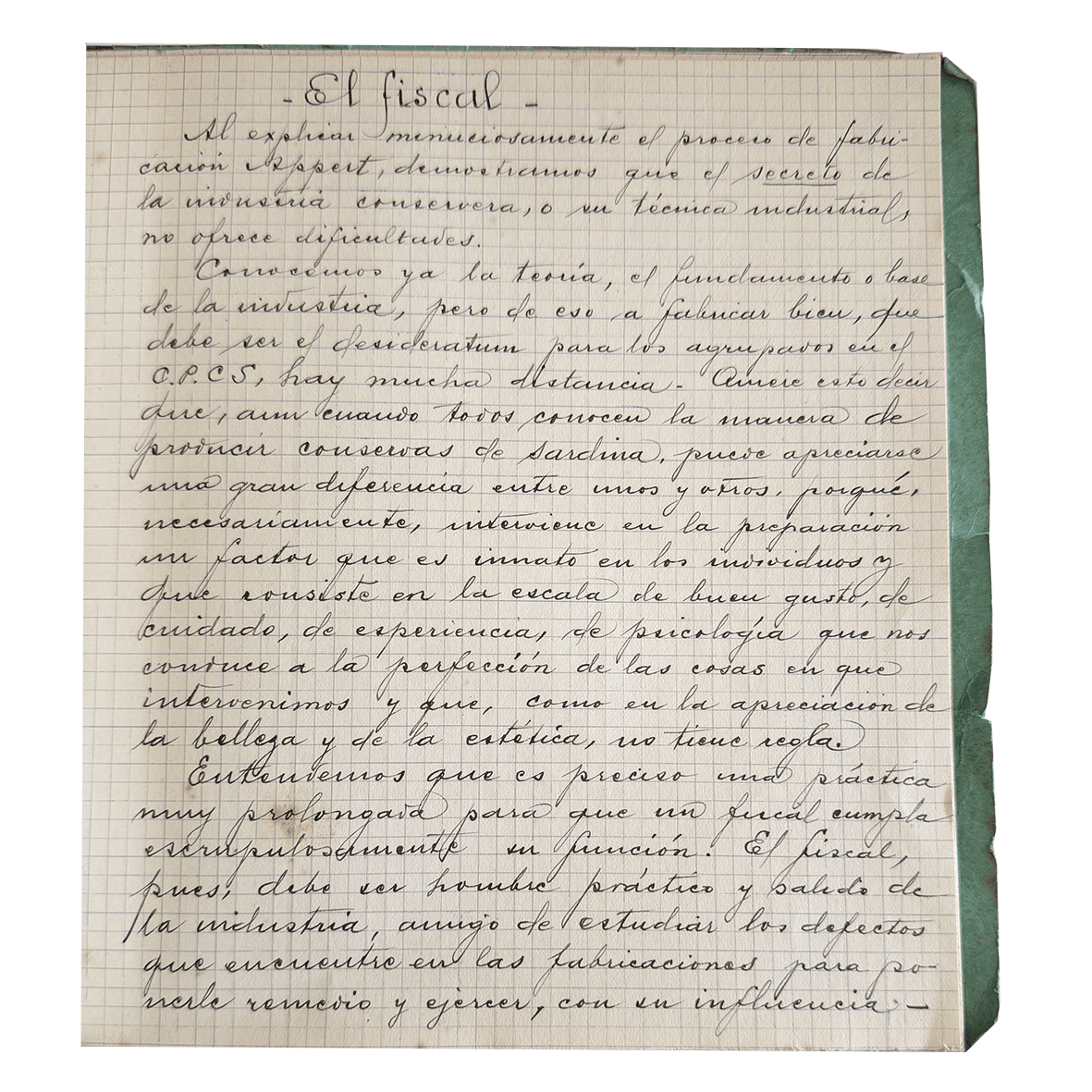
El fiscal
Al explicar minuciosamente el proceso de fabricación Appert, demostraremos que el perito de la industria conservera, o un técnico industrial, no ofrece dificultades.
Conocido ya la teoría, el fundamento base de la industria; pero de eso a fabricar bien, que debe ser el desiderátum para los aspirantes al C.P.C.S., hay mucha distancia. Prueba esto sería decir aun cuando todos conozcan la manera de fabricar conservas de sardina, puede apreciarse una gran diferencia entre unos y otros, porque necesariamente interviene en la preparación un factor que es innato en los individuos y que, invisible en la escala de buen gusto, se cuida de experiencias, de sacrificios que nos conduce a la perfección de las cosas en que intervenimos y que —como en la apreciación de la belleza y de la estética— no tiene receta.
Entendemos que es precisa una práctica muy prolongada para que un fiscal cumpla escrupulosamente su función. El fiscal, pues, debe ser humilde, modesto, y salido de la industria, amigo de estudiar los defectos que encuentra en las fabricaciones para saber remediarlos y ejercer, con su influencia que no tendría si desconociese profundamente la fabricación en sus más sencillas manipulaciones.
La persuasión que nos lleve a una transformación paulatina.
The Inspector
By thoroughly explaining the Appert manufacturing process, we will demonstrate that a specialist in the canning industry, or an industrial technician, will not encounter difficulties.
Once the theory is understood — the foundational basis of the industry — moving from theory to producing well is quite a leap. This is especially true for candidates of the C.P.C.S., for whom proper manufacturing should be the ultimate goal. The distance is evident even when everyone knows how to produce canned sardines, yet clear differences can still be observed between one product and another. This is because an essential factor comes into play — something innate to each individual, which, though invisible on any scale of good taste, is nurtured through experience and sacrifice. It is this which leads to the perfection of the things we undertake, and — just like in the appreciation of beauty and aesthetics — it cannot be taught by formula.
We believe that extensive practical experience is required for an inspector to fulfil their duties conscientiously. The inspector must therefore be humble, modest, and come from within the industry, eager to study the defects encountered in production so as to know how to correct them and to carry out their role with influence which it would not have if it were profoundly unfamiliar with the manufacturing process in its simplest operations.
The persuasion that leads us toward a gradual transformation.
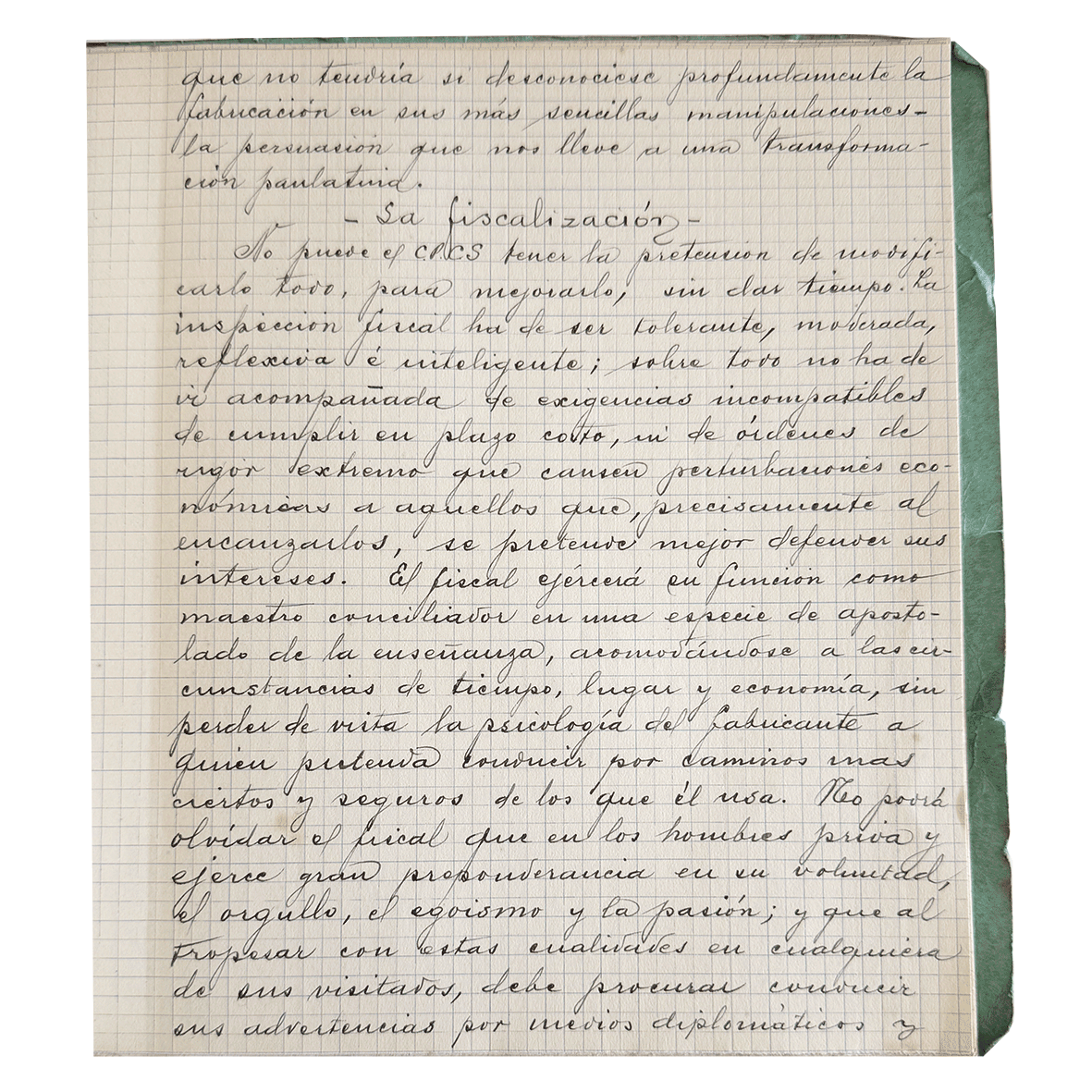
La fiscalización
No puede el C.P.C.S. tener la pretensión de purificarlo todo, para mejorarlo, sin dar tiempo. La inspección fiscal ha de ser tolerante, moderada, reflexiva e inteligente; y alos (sic) todo no ha de ir acompañada de exigencias incompatibles de cumplir en plazo corto, ni de órdenes de rigor extremo que causen perturbaciones económicas a aquellos que, precisamente al fiscalizado, se proponen mejorar defectos en sus intereses.
El fiscal ejercerá su función como maestro orientador en una especie de apostolado de la enseñanza, acomodándose a las circunstancias de tiempo, lugar y economía, sin perder de vista la resolución de educar a quien pretenda recorrer por caminos más rectos y seguros, de los que él usa.
No podrá olvidar la rivalidad que en los hombres privados ejerce gran predominancia en su industria; los celos, el egoísmo, la pasión; y, cualquiera que sea su visita, establecida en ausencia de sus visitados, debe procurar encubrir sus advertencias por medios diplomáticos persuasiva que no lastime un interesarse precario y tan humano.
Inspection and Oversight
The C.P.C.S. cannot claim to purify everything in order to improve it, without allowing time. Fiscal inspection must be tolerant, moderate, thoughtful, and intelligent; and it must not be accompanied by demands that are impossible to meet within a short timeframe, nor by overly harsh orders that cause economic disruptions to those — often the very ones being inspected — who are genuinely seeking to correct faults in their operations.
The inspector should carry out their duties as a guiding teacher, in a kind of educational mission, adapting to the circumstances of time, place, and economic reality, while never losing sight of the goal of educating those who wish to follow a straighter, safer path than the one they currently tread.
They must not forget the rivalry that often dominates private enterprises; the jealousy, egoism, and passion — and whatever the nature of the inspection, particularly if conducted in the absence of those being visited, the inspector should aim to deliver observations and recommendations through diplomatic means a persuasive approach that does not harm a precarious and very human livelihood.
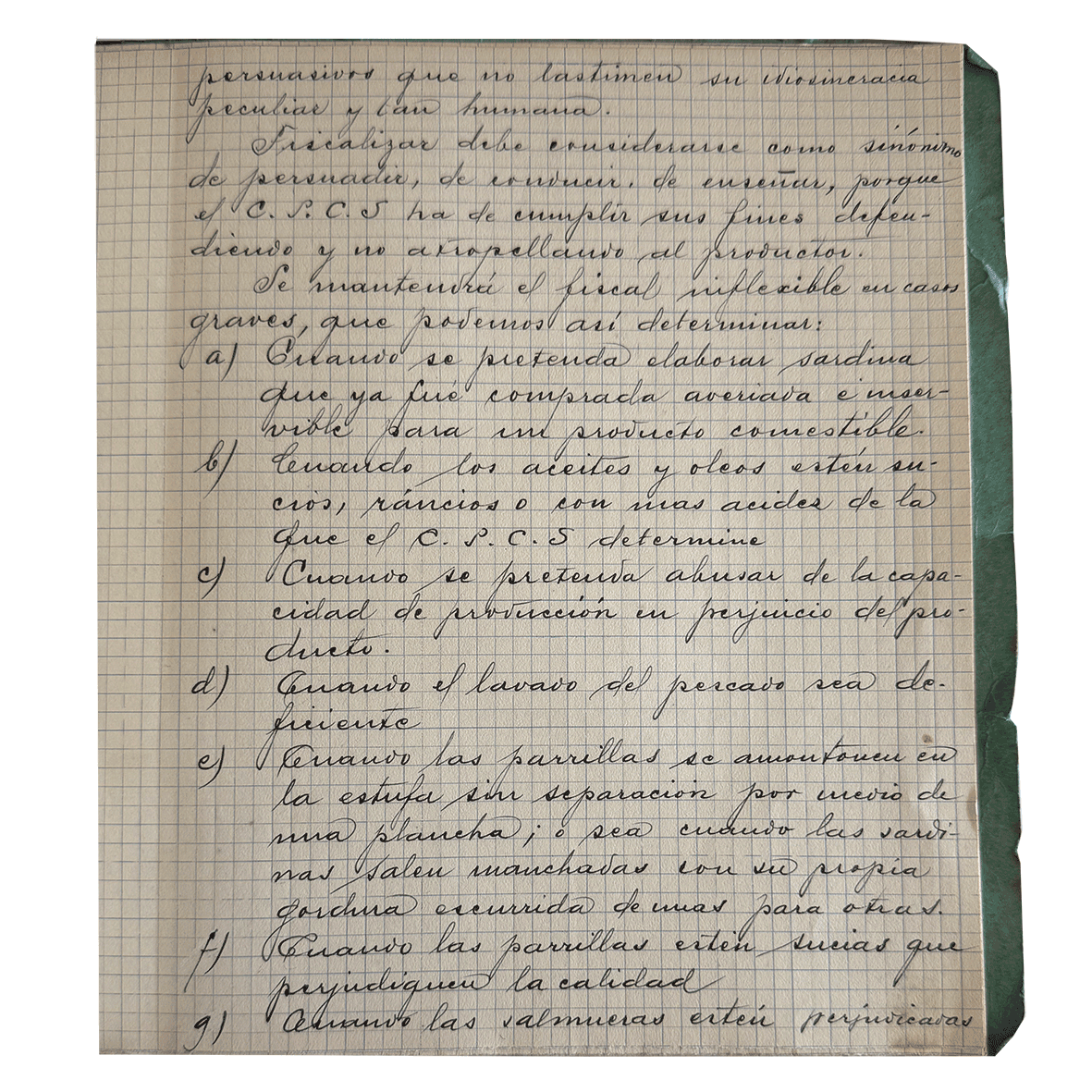
Se señalará este mantenimiento como síntoma de serenidad de espíritu de enseñanza, porque el C.P.C.S. no se cumple sino fines de depuración y no acorralando al productor.
Se mantendrá el fiscal inflexible en casos graves que perentoriamente determinará:
a) Cuando se pretenda elaborar sardina que ya fue comprada averiada o insalubre para un producto comestible.
b) Cuando los aceites y oleos estén rancios, rancios o con unos ácidos de los que el C.P.C.S. determine.
c) Cuando se pretenda abusar de la capacidad de producción en perjuicio del producto.
d) Atados y lavados de pescados secos de higiene.
e) Cuando las parrillas se amontonen en la estufa sin separación por medio de una plancha: o sea cuando los sardinas salen manchadas en vez propias (fenómeno corriente de unas sardinas).
f) Cuando las parrillas estén sucias que perjudiquen la calidad.
g) Cuando las almueras estén perjudicadas por servir demasiadas vezes.
This approach should be seen as a sign of a calm and educational spirit, since the aim of the C.P.C.S. is purification — not to corner or punish the producer.
However, the inspector must remain inflexible in serious cases, which will be determined as follows:
a) When there is an attempt to process sardines that were already purchased in a spoiled or unfit state for human consumption.
b) When oils or greases are rancid or have levels of acidity beyond those established by the C.P.C.S.
c) When there is an attempt to overuse production capacity to the detriment of product quality.
d) When fish are tied and washed without proper hygiene.
e) When the grills are overcrowded in the oven without separation by means of a tray — in other words, when the sardines come out stained rather than clean (a common issue with poorly spaced sardines).
f) When the grills are dirty and affect product quality.
g) When the brines are compromised from being reused too many times.
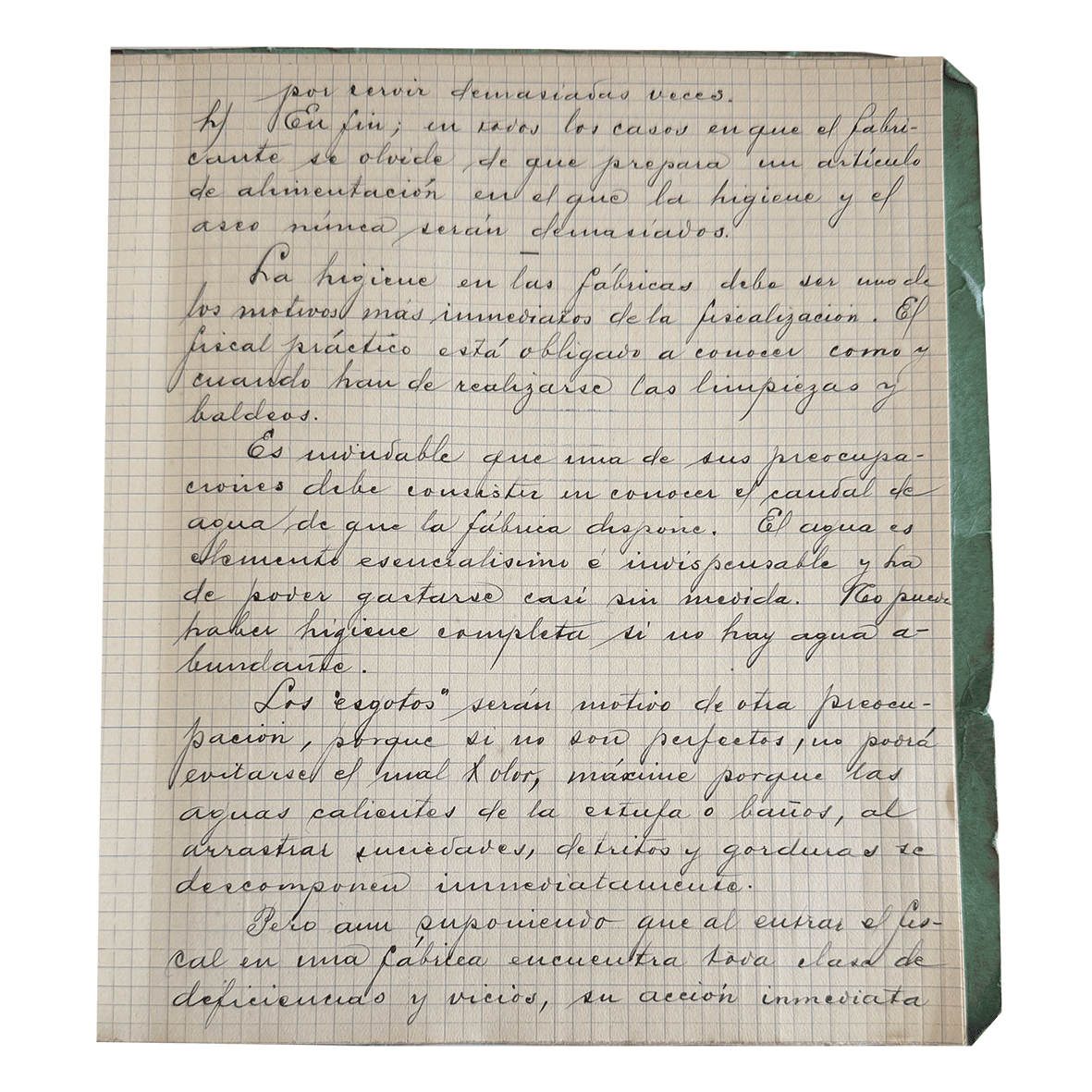
h) Por último, en cualquier caso en que el fabricante esté elaborando un producto alimenticio en el que la higiene y el control sanitario sean claramente deficientes.
En las fábricas, la limpieza es uno de los aspectos más esenciales de la fiscalización. Un fiscal práctico debe saber con exactitud cómo y cuándo deben realizarse las limpiezas y el fregado de suelos.
Es indudable que una de sus preocupaciones principales debe consistir en asegurar la limpieza continua dentro de la fábrica. El agua es un elemento esencial e indispensable — debe estar siempre disponible y usarse generosamente. No puede haber higiene completa si no hay agua abundante.
Los “desagües” son motivo de otra preocupación, ya que si no están en perfecto estado, pueden desprender mal olor, sobre todo porque los residuos de los cortes y lavado del pescado —sangre, vísceras, despojos y grasa— se descomponen casi de inmediato.
Pero aún peor sería que el fiscal, al llegar a una fábrica, encontrase los desagües en un estado lamentable, con olores y residuos, lo que requeriría una actuación inmediata no debe ser la denuncia al C.P.C.S.
h) Finally, in any case where the manufacturer is clearly producing a food product in which hygiene and safety standards are seriously lacking.
In factories, cleanliness is one of the most essential aspects of inspection. A practical inspector must know exactly how and when cleaning and floor-washing should be carried out.
It is undeniable that one of their primary concerns must be to ensure the continuous cleanliness of the factory. Water is an essential and indispensable element — it must be readily available and used generously. There can be no complete hygiene without a plentiful water supply.
The “drains” are another major concern, since if they are not in perfect condition, they can produce a foul odour — especially because the waste from cutting and washing fish includes blood, intestines, and fat, which decompose almost immediately.
Even worse, if the inspector were to arrive and find the drains in such a factory in a deplorable state, with foul odours and residues, immediate action would be necessary should not immediately result in a report to the C.P.C.S.
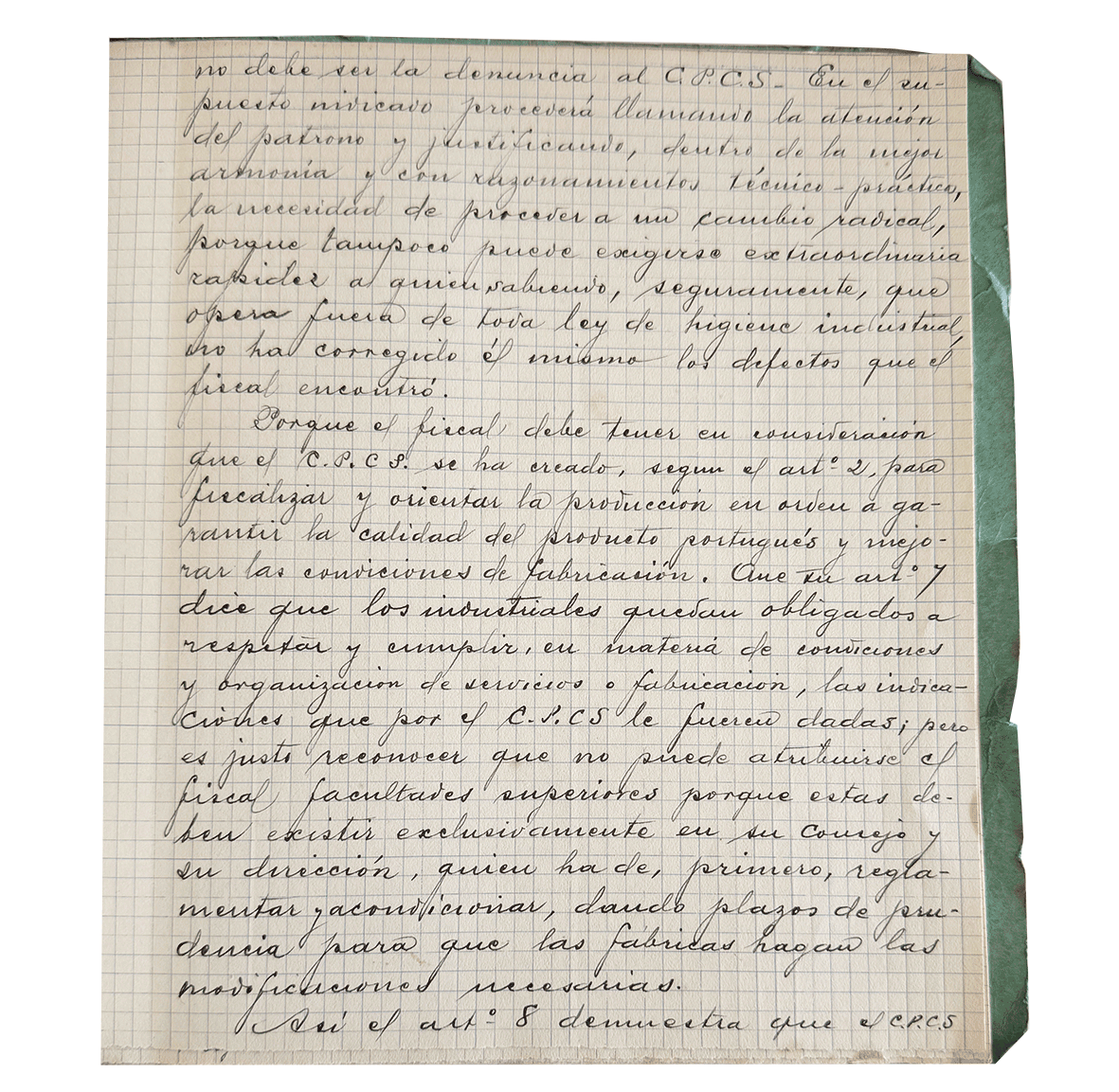
El fiscal, puesto minucioso, procurará llamar la atención del patrón o responsable, con tono de la mejor armonía. Si el esfuerzo resulta inútil, si subsiste la necesidad de proceder a un cambio laboral, porque tampoco puede conseguirse satisfactoria calidad a quien sabiendo, frecuentemente que- branta fuera de toda ley de higiene industrial, y no ha corregido él mismo los defectos que el fiscal encontró:
Porque el fiscal debe tener en consideración que el C.P.C.S. se ha creado, según el art. 1, para fiscalizar y orientar la producción en orden a garantizar la calidad del producto conservado e mejorar las condiciones de fabricación. Que el art.º 1.º dice que los industriales quedan obligados a respetar y cumplir en materia de conservas y organización de servicios y fabricaciones sanitarias.
Conviene que por el C.P.C.S. se fueran dadas – es justo reconocer que no puede atribuirse al fiscal facultades imprevistas porque estas deben existir exclusivamente en un consejo o en dirección quien ha de, primero, reglamentar y administrar dando plazos de prudencia para que las fábricas hagan las modificaciones necesarias.
Rather, the inspector must first attempt to draw the attention of the manager with calm, tact, and a spirit of harmony. If the issue persists after such efforts, and it becomes clear that a change in staff is needed — because it is impossible to achieve satisfactory results with someone who knowingly and repeatedly violates the local law or the very principles of industrial hygiene — then, and only then, should a formal report be filed.
Because the inspector must bear in mind that the C.P.C.S. was created, according to Article 1, to supervise and guide production in order to ensure the quality of preserved products and improve manufacturing conditions. Article 1 states that industrialists are obliged to respect and comply with matters relating to preservation, service organisation, and sanitary manufacturing conditions.
It is fair to recognise that the C.P.C.S. cannot arbitrarily enforce urgent changes, because such powers are reserved solely for a body or direction that must first set the rules and general framework, allowing factories to carry out the necessary modifications.
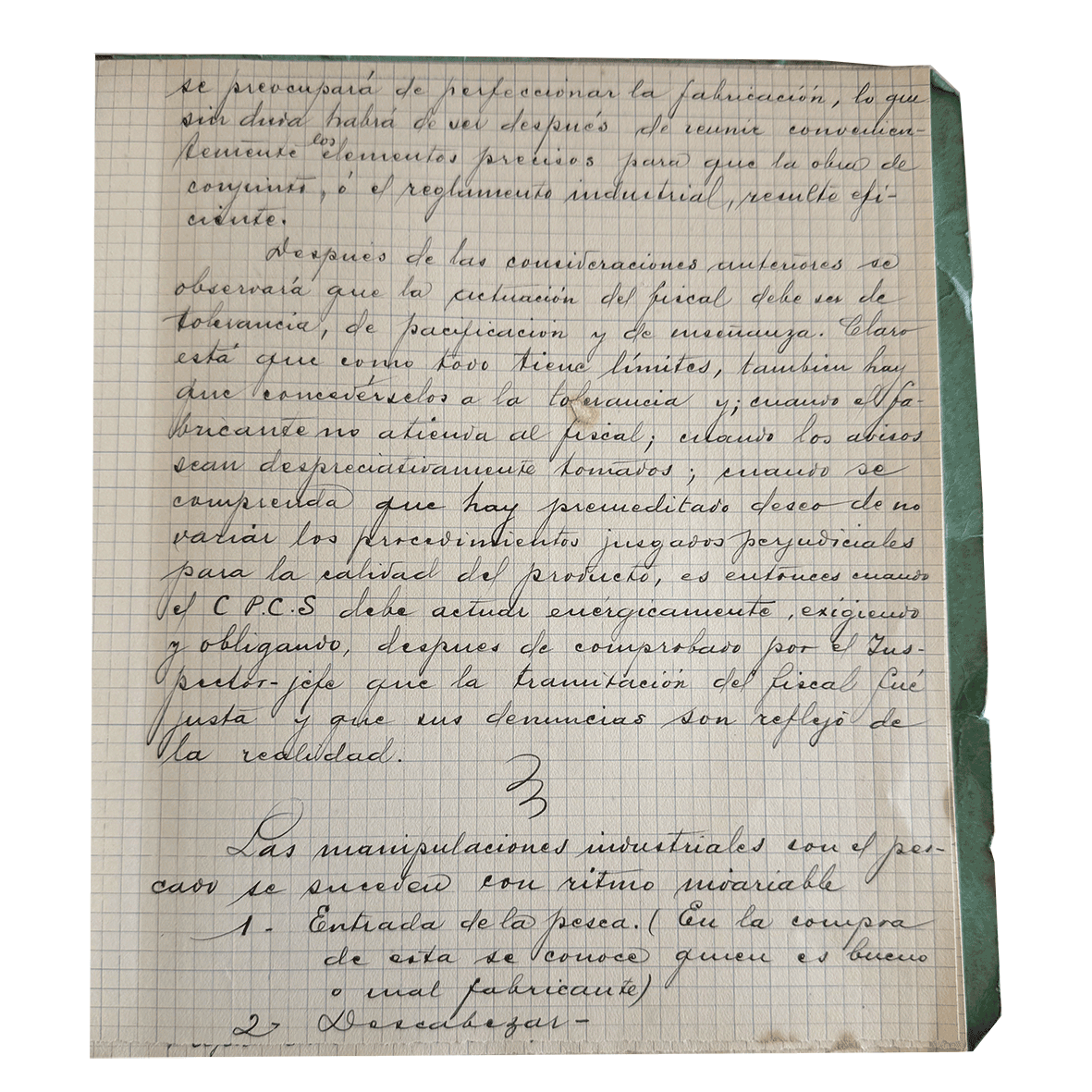
El artículo 8 deja también en claro que el C.P.C.S se presenta, se reexamina la fabricación, lo que sin duda habrá de ser después del examen comunal.
Remueve los momentos precisos para que la salud de conjunto, y el rendimiento industrial, resulte óptimo.
Después de las consideraciones anteriores se observará que la conducta del fiscal debe de ser tolerante y de persuasión. Es menester. Claro está que como todo tiene límites, también hay que someterlos a la razón, y cuando el fabricante no atienda al fiscal, o bien los abusos sean despreciablemente tomados, o merito de pruebas que hay premeditados deseos de no variar los procedimientos juzgados perjudiciales para la calidad del producto, se estima que el C.P.C.S. debe actuar enérgicamente, exigiendo y obligando, después de conversado por su fiscal jefe, que la dimisión del fiscal fue justa y que sus denuncias son reflejo de la realidad.
Las manipulaciones industriales son el proceso que se sucede con ritmo invariable:
- Entrada de la pesca. (en la compra de esta se conoce quién es buen o mal fabricante)
- Descabezar
Article 8 also makes clear that the C.P.C.S. is present, and that the manufacturing process is re-examined — something that will undoubtedly take place after the communal inspection.
It intervenes at the key moments to ensure that overall health and industrial performance reach optimal levels.
Following the previous considerations, it is clear that the inspector’s conduct must be one of tolerance and persuasion. This is essential. Of course, as with everything, there are limits — and reason must prevail. When the manufacturer fails to heed the inspector, or when abuses are dismissed with disregard, or there is sufficient evidence of a deliberate unwillingness to change practices considered harmful to product quality, it is then deemed that the C.P.C.S. must act firmly, demanding and enforcing compliance — and, following discussion with the chief inspector, validating that the inspector’s report was justified and his claims a reflection of reality.
Industrial operations follow a process of consistent rhythm:
- Arrival of the fish (from the purchase, one can already tell who is a good or poor manufacturer)
- Beheading

3 – Salmuera
4 – Emparrillar
5 – Lavar
6 – Cocer
7 – Enlatar
8 – Aceitar
9 – Cerrar o sellar
10 – Esterilizar
11 – Limsial
12 – Revisar
13 – Encajonar – almuenar
14 – Exportar
(Cuando las operaciones 2 – 4 – 7 se hacen por “empreitada”, se comete un crimen de lesa industria. No hay fabricación buena hecha recurriendo a la “empeitada”. Al C.P.C.S. compete prohibir ese medio de trabajo y debe hacerlo con urgencia.)
Veamos cuáles deben ser las funciones fiscalizadoras:
- Entrada de la pesca. Ver si responde a una fabricación normal. Desechar lo que, en conjunto, venga en condiciones inadmisibles para un producto comestible.
- Descabezar. Recomendar que la tripa sea extraída totalmente. Es un de punto grave muy señalado, o al que no le dan importancia los industriales portugueses.
3 – Brining
4 – Racking (placing fish on grills)
5 – Washing
6 – Cooking
7 – Canning
8 – Oiling
9 – Sealing or closing
10 – Sterilising
11 – Cleaning
12 – Inspecting
13 – Boxing – brining
14 – Exporting
(When operations 2, 4, and 7 are carried out on a piecework basis, it constitutes a crime against the industry. There can be no proper manufacturing when resorting to piecework. It is the responsibility of the C.P.C.S. to prohibit this working method — and to do so urgently.)
Let us examine what the inspector’s functions should be:
- Arrival of the fish. Ensure it meets the standards for normal production. Reject anything that, overall, arrives in a condition unfit for a food product.
- Beheading. Recommend that the entrails be fully removed. This is a very serious issue — one that Portuguese manufacturers often fail to give due importance to.
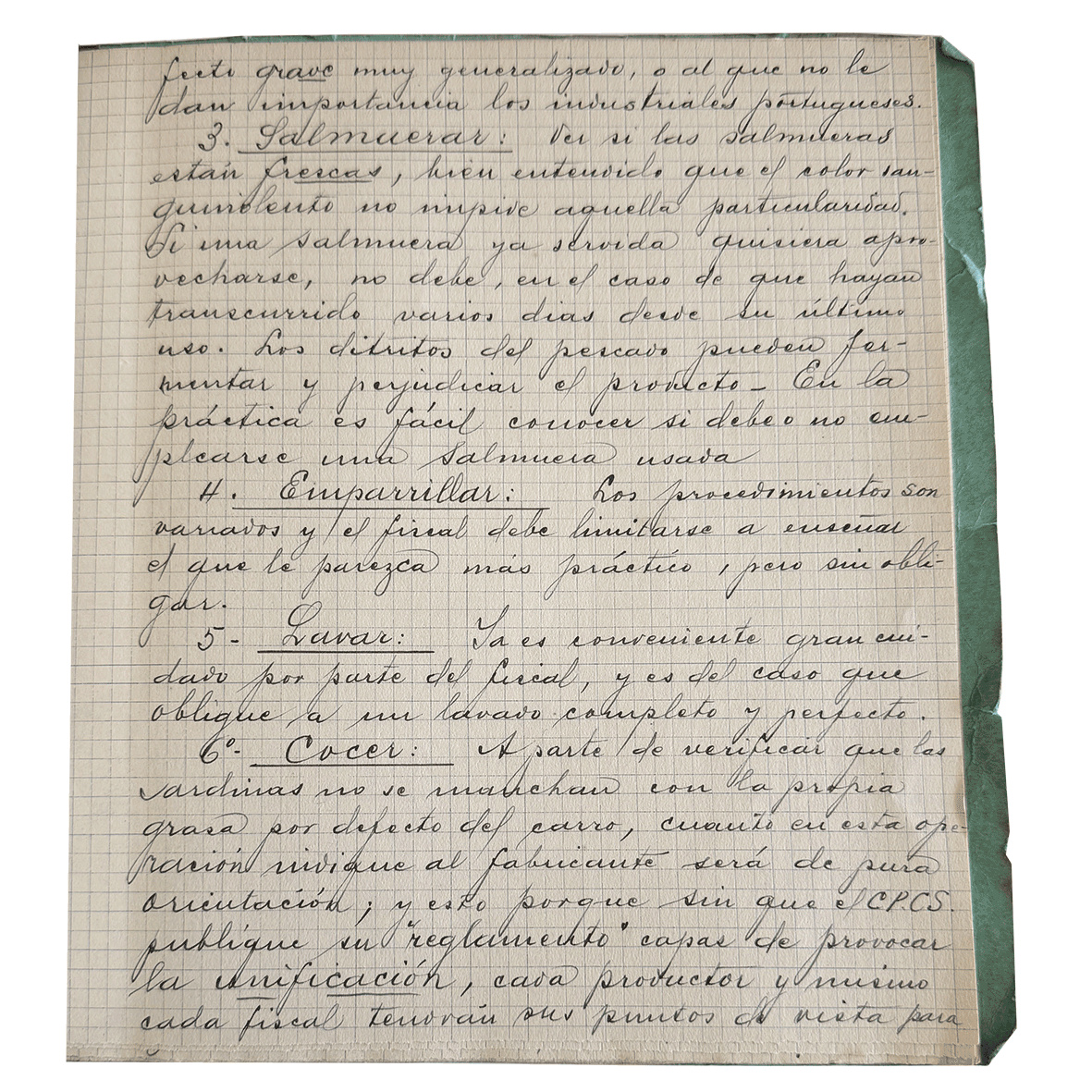
3. Salmuera: Ver si las salmueras están frescas, bien curadas, que el olor no gurmiente, no inspire aquella particularidad de una salmuera ya usada, rancia o apurada. No debe, en caso de que hayan recurrido a salmueras, decirse su última uso. Los circuitos del pescado pueden fermentarse y perjudicar el producto. En la práctica es fácil conocer si debe o no emplearse una salmuera usada.
4. Emparrillar: Los procedimientos son variados y el fiscal debe limitarse a revisar el que le parezca más práctico y, por su utilidad.
5. Lavar: Ya es conveniente gran cuidado por parte del fiscal, y es el caso que obligue a un lavado cabal, correcto y perfecto.
6. Cocer: Aparte de verificar que las sardinas no se malhechen con la propia grasa por defecto del cuido, cuando el agua hervida mitigue al fabricante se dará justa orientación a esto, porque bien que el C.P.C.S. publique un reglamento capaz de provocar la unificación, cada producto y enunciado fiscal tendrán sus puntos de vista para apreciar el punto exacto de la cocción, es uno de esos puntos que, en verdad, quien lo posee —sin duda muy equivocadamente— se estima superior a los demás.
3. Brining: Check whether the brine is fresh, properly prepared, and that it does not emit a pungent or stale smell, nor show signs of being reused or overly diluted. In the event that reused brine is being employed, its last use should be clearly indicated. The surface of the fish may ferment and this would harm the product. In practice, it is easy to tell whether or not used brine is suitable for reuse.
4. Racking (placing on grills): Methods vary, and the inspector should limit themselves to reviewing the one that appears most practical and efficient.
5. Washing: Great care is required here from the inspector. If necessary, they should insist on a thorough and proper wash.
6. Cooking: In addition to verifying that the sardines are not spoiled by their own fat due to poor handling, if the manufacturer boils them improperly, clear guidance should be given. Even if the C.P.C.S. were to publish a regulation aimed at standardising the method, each product and inspector would still have their own points of view regarding to assess the exact point of cooking is one of those matters where those who master it — wrongly, no doubt — consider themselves superior to others.
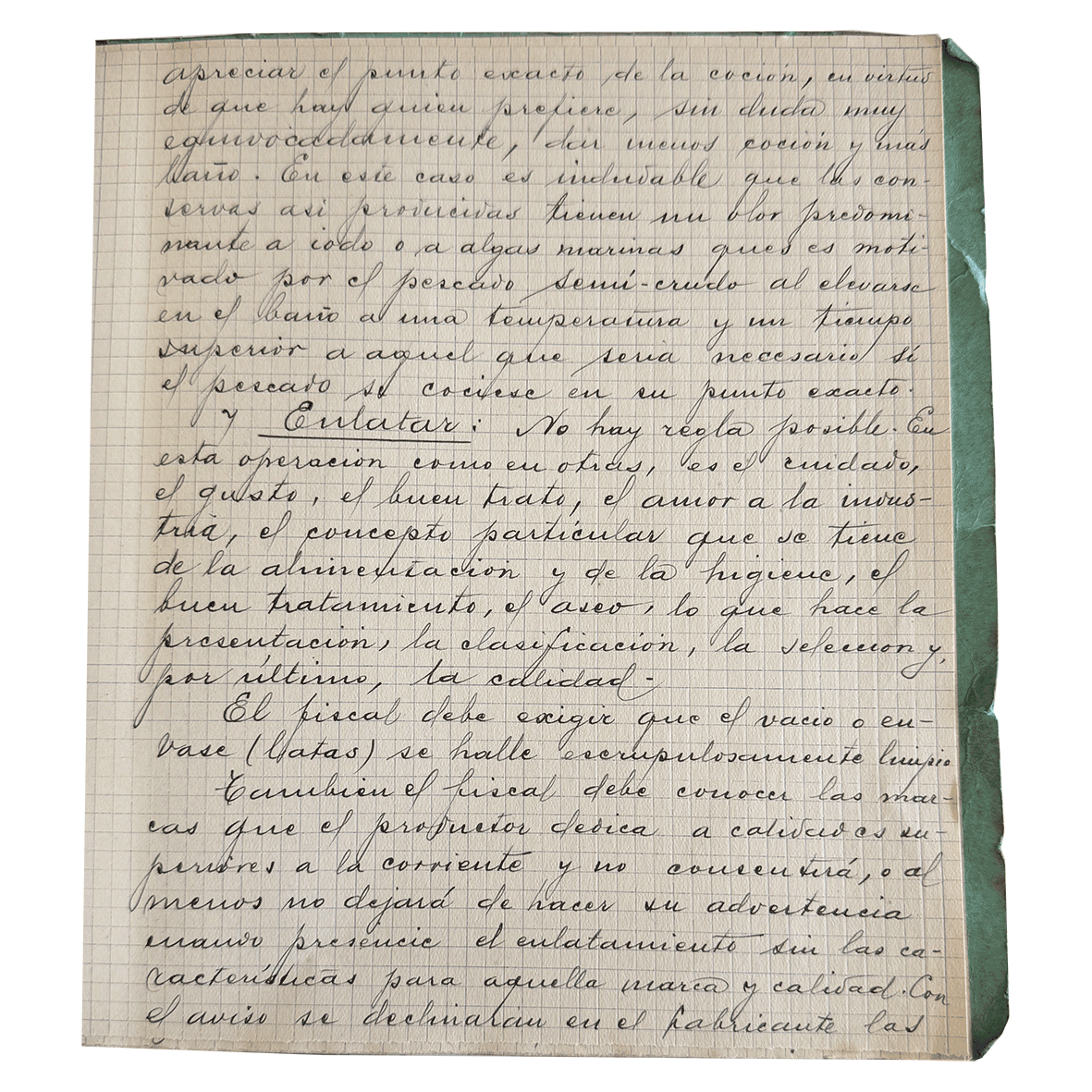
Pero este caso es ilusorio. Los servidores del C.P.C.S. tienen un libro precisamente a ello, con aguas marinas que se midieron y pesaron. Semi-crudo o hervido, se evalúa en temperatura y en tiempo superior a aquel que sea necesario si el pescado se cuece en un punto exacto.
7. Enlatar: No hay regla escrita. En esta operación como en otras, lo deciden el gusto, el buen estilo, el amor a la industria, el concepto particular que se tiene de la alimentación y de la higiene, el buen tratamiento, el aseo —lo que hace la presentación, la clasificación, la selección y, por último, la delicadeza.
El fiscal debe exigir que el vaso o envase (latas) se halle escrupulosamente limpio.
También el fiscal debe conocer las marcas que el productor desea o acostumbra a reservar a la exportación y a consumidores, y al menos no dejar de hacer una advertencia cuando presencie el enlatamiento en las características para aquella marca y calidad. Con aviso se deslindarán en el fabricante consecuencias que pueden venirle al clasificar oficialmente el lote y extendérselo el certificado de calidad.
El enlatado exige limpieza, uso personal y cuidadoso sin errores.
But this belief is misleading. The C.P.C.S. officials have a manual dedicated precisely to this, using measured and weighed seawater. Whether semi-cooked or boiled, the process is evaluated by temperature and the time required, provided the fish is cooked to the exact point.
7. Canning: There is no written rule. In this operation, as in others, it is determined by taste, good practice, a love for the industry, the individual’s understanding of food and hygiene, proper handling, cleanliness — all of which influence presentation, classification, selection, and ultimately, finesse.
The inspector must insist that the container (the cans) be scrupulously clean.
The inspector must also be aware of the brands the producer reserves for export or specific customers, and at the very least, make a note or recommendation if they witness canning under conditions that do not match the standards associated with that brand or quality. With such notice, responsibility will then rest with the manufacturer consequences that may arise when the batch is officially classified and the certificate of quality is issued.
Canning requires cleanliness, personal and careful handling, and must be free of errors.
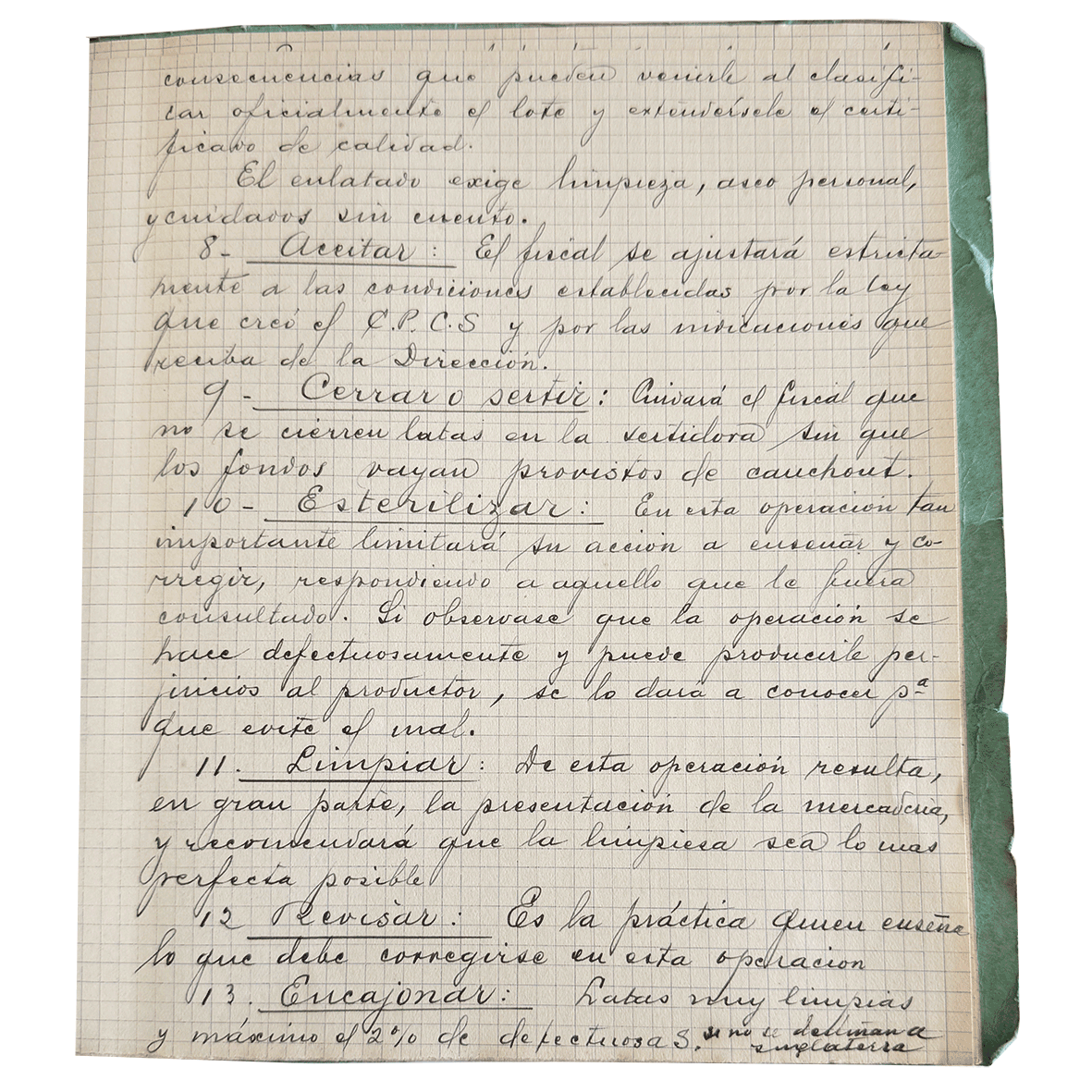
8. Aceitar: El fiscal se ajustará estrictamente a las condiciones establecidas por la ley que creó el C.P.C.S. y por las instrucciones que vengan de la Dirección.
9. Cerrar o sellar: Avisará el fiscal que no se cierren latas en la vertedera sin que los fondos vayan provistos de caucho.
10. Esterilizar: En esta operación tan importante limitará su acción a revisar y corregir, respondiendo a aquello que le fuere consultado. Si observase que la operación se hace defectuosamente y puede producir perjuicios al producto, se lo dará a conocer a quien esté al mando.
11. Limpiar: De esta operación resulta en gran parte la presentación de la mercancía, y secundariamente que la limpieza sea lo más perfecta posible.
12. Revisar: En la práctica quien enseña lo que debe corregirse en esta operación.
13. Encajonar: Actos muy limitados y máximo el 2% de deficiencias se…
8. Oiling: The inspector shall strictly adhere to the conditions established by the law that created the C.P.C.S., as well as to the instructions issued by the Directorate.
9. Sealing or Closing: The inspector should ensure that no tins are sealed at the filling station without first ensuring that the bases are properly fitted with rubber rings.
10. Sterilising: In this critically important stage, the inspector’s role is mainly to supervise and correct issues, and to respond to any questions raised. If the inspector observes that the operation is being carried out incorrectly and could cause harm to the product, they must report it to the supervisor in charge.
11. Cleaning: This operation has a major influence on the product’s presentation and, secondarily, ensures that cleanliness is as perfect as possible.
12. Inspecting: In practice, it is the inspector who points out what needs to be corrected during this stage.
13. Boxing: This task is quite limited in scope, and a maximum of 2% of defects is…
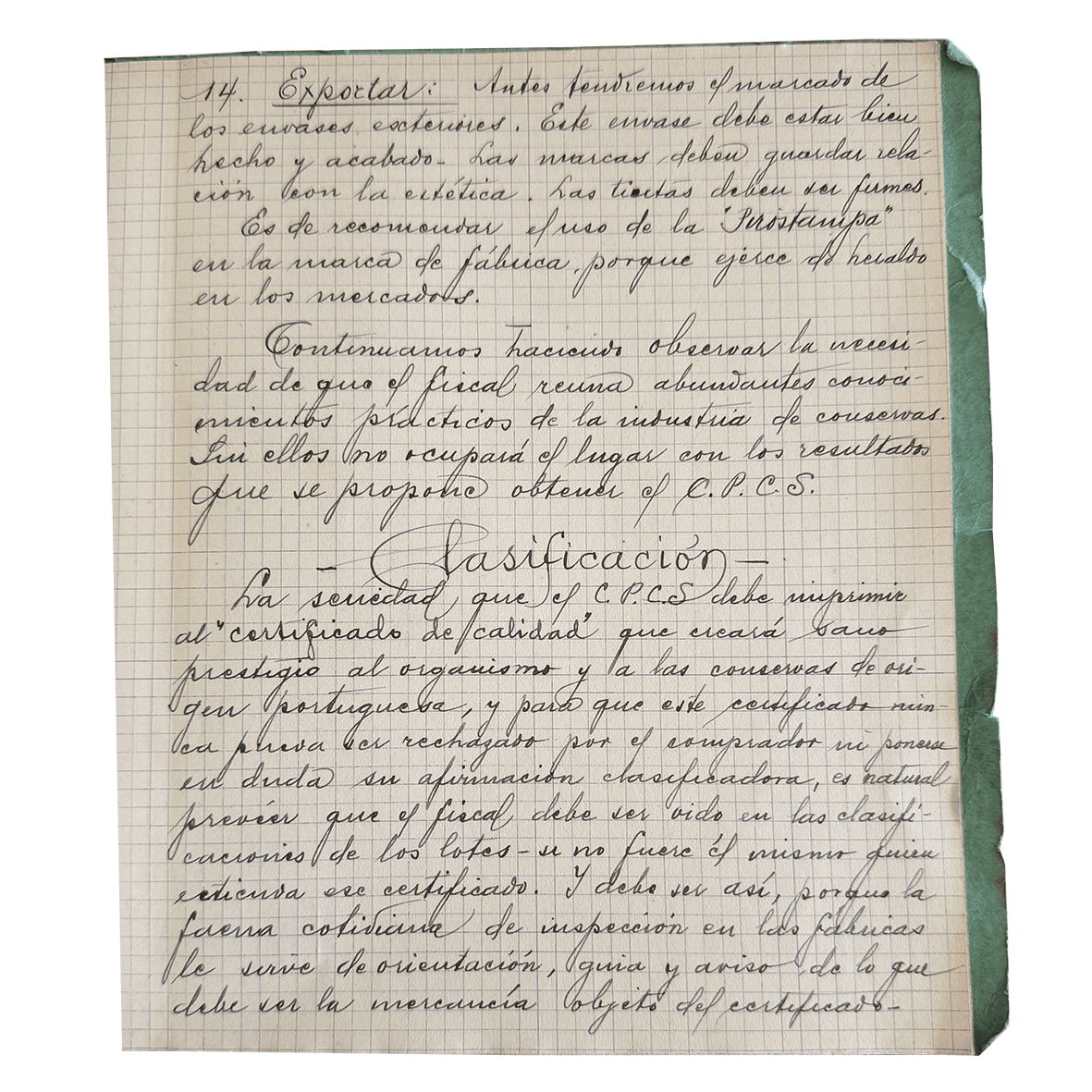
14. Exportar:
Antes pondremos aprecio en los envases exteriores. Este envase debe estar bien hecho y acabado. Las marcas deben guardar relación con la etiqueta, las tintas deben ser firmes.
Es de recomendar el uso de la Pirostampa en la marca de fábrica porque ejerce efecto en los mercados.
Continuamos haciendo observar la necesidad de que el fiscal reúna abundantes conocimientos prácticos de la industria de conservas.
En ellos ha ocupado el lugar en los resultados que se propone obtener el C.P.C.S.
14. Export:
Beforehand, we should pay special attention to the external packaging. The packaging must be well-made and finished. The labels must correspond to the content, and the inks must be firm.
The use of Pirostampa on the factory mark is recommended, as it has an effect in the marketplace.
We continue to stress the importance that the inspector (fiscal) must possess ample practical knowledge of the canning industry.
It is in these matters that the outcomes sought by the C.P.C.S. are determined.
Clasificación
La seriedad que el C.P.C.S. debe imprimir al certificado de calidad que encierra tanto prestigio al otorgarse a las conservas de origen portugués, y parte que este certificado no pueda ser rechazado por el consumidor ni puesto en duda en aplicaciones vinculadoras, la naturaleza exige que el fiscal debe ser cauto al clasificar envases y los lotes —si no fuere el mismo quien estuviere ese certificado— y debe ser, por tanto, un buen continuo de inspección en toda fábrica.
Se requiere de orientación técnica y de la que debe ver la mercancía objeto del certificado.
Classification
The seriousness with which the C.P.C.S. must endorse the certificate of quality, which carries such prestige when awarded to canned goods of Portuguese origin, demands that this certificate not be rejected by the consumer nor questioned in binding applications.
It is essential that the inspector exercises caution when classifying containers and batches — if he is not the one issuing the certificate himself — and that he carries out continuous and consistent inspection in every factory.
Technical guidance is required, as well as the ability to properly assess the goods being certified.
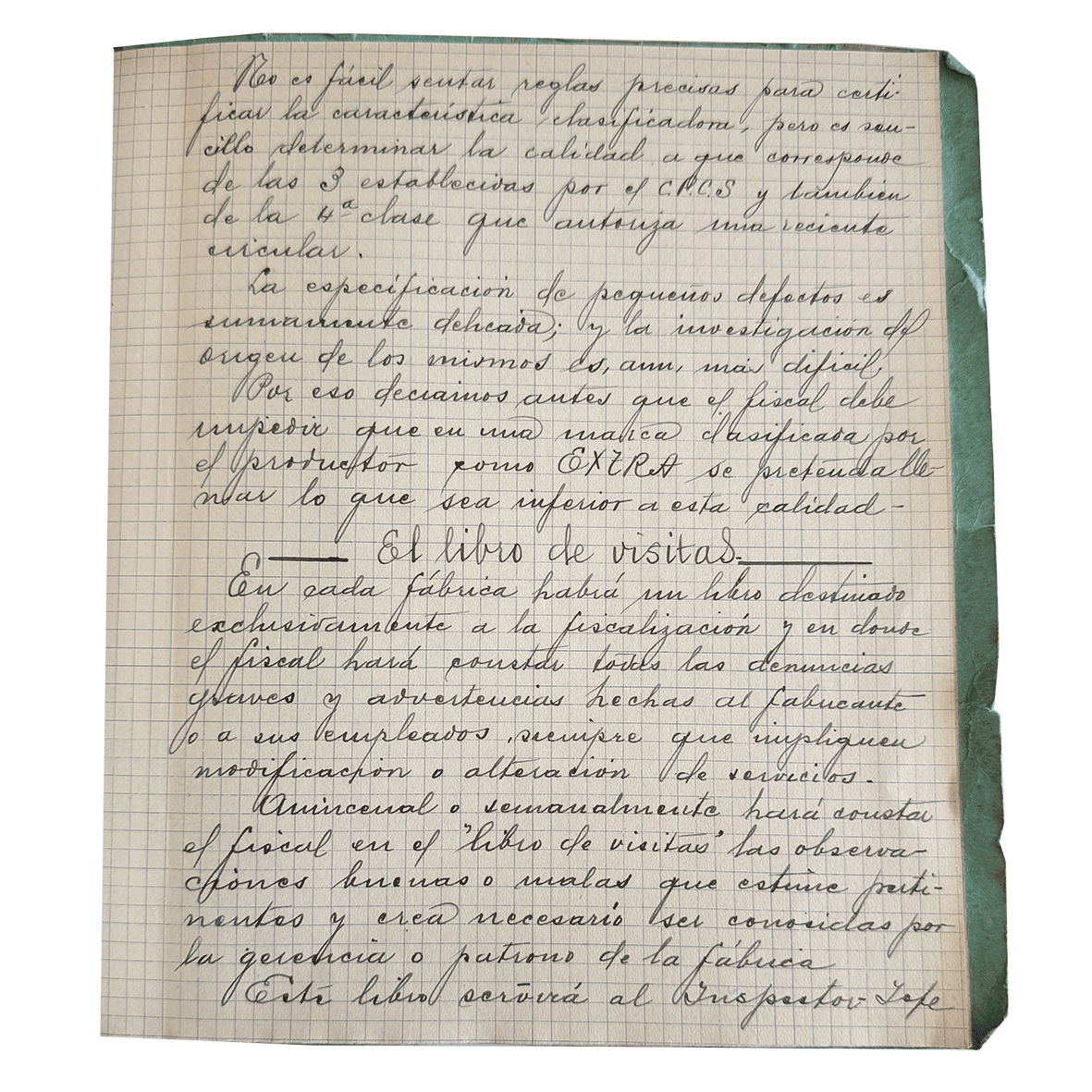
No es fácil pesar todas las razones para calificar las características tipificadoras, pero en ellas determinan la calidad a que corresponde de las 3 establecidas por el C.P.C.S. y también de la 5ª clase que constituye una simple circulación.
La especificación de pequeños defectos es sumamente delicada. Y la investigación del origen de los mismos no es menos.
Por eso decíamos antes que el fiscal debe imponer que en una marca tipificada por el productor como EXTRA se presente allí solo lo que sea inferior a esta calidad.
El libro de visitas
En cada fábrica habrá un libro destinado exclusivamente a la fiscalización y en dicho el fiscal hará constar todas las denuncias justas y advertencias hechas al fabricante o a sus empleados siempre que impliquen modificación o dirección en el trabajo.
Anualmente o semestralmente hará constar el fiscal en el libro de visitas las observaciones diversas vitales que estime pertinentes y crea necesario hacer conocer por la gerencia o patronos de la fábrica.
Este libro servirá al Inspector Jefe…
It is not easy to weigh all the reasons for qualifying the defining characteristics, but these determine the quality corresponding to one of the three classes established by the C.P.C.S., as well as the fifth class, which merely allows circulation.
The specification of minor defects is extremely delicate. And investigating their origin is no less so.
That is why we mentioned earlier that the inspector must ensure that in a batch labelled by the producer as EXTRA, only what is strictly of that quality is included — nothing inferior.
The visitors’ book
In every factory, there shall be a book designated exclusively for inspection purposes, in which the inspector shall record all justified complaints and warnings made to the producer or to any employees, whenever they imply a change or direction in the work.
Annually or semi-annually, the inspector shall record in the visitors’ book any vital observations that they consider appropriate or necessary to be communicated to the management or owners of the factory.
This book shall serve the Chief Inspector…
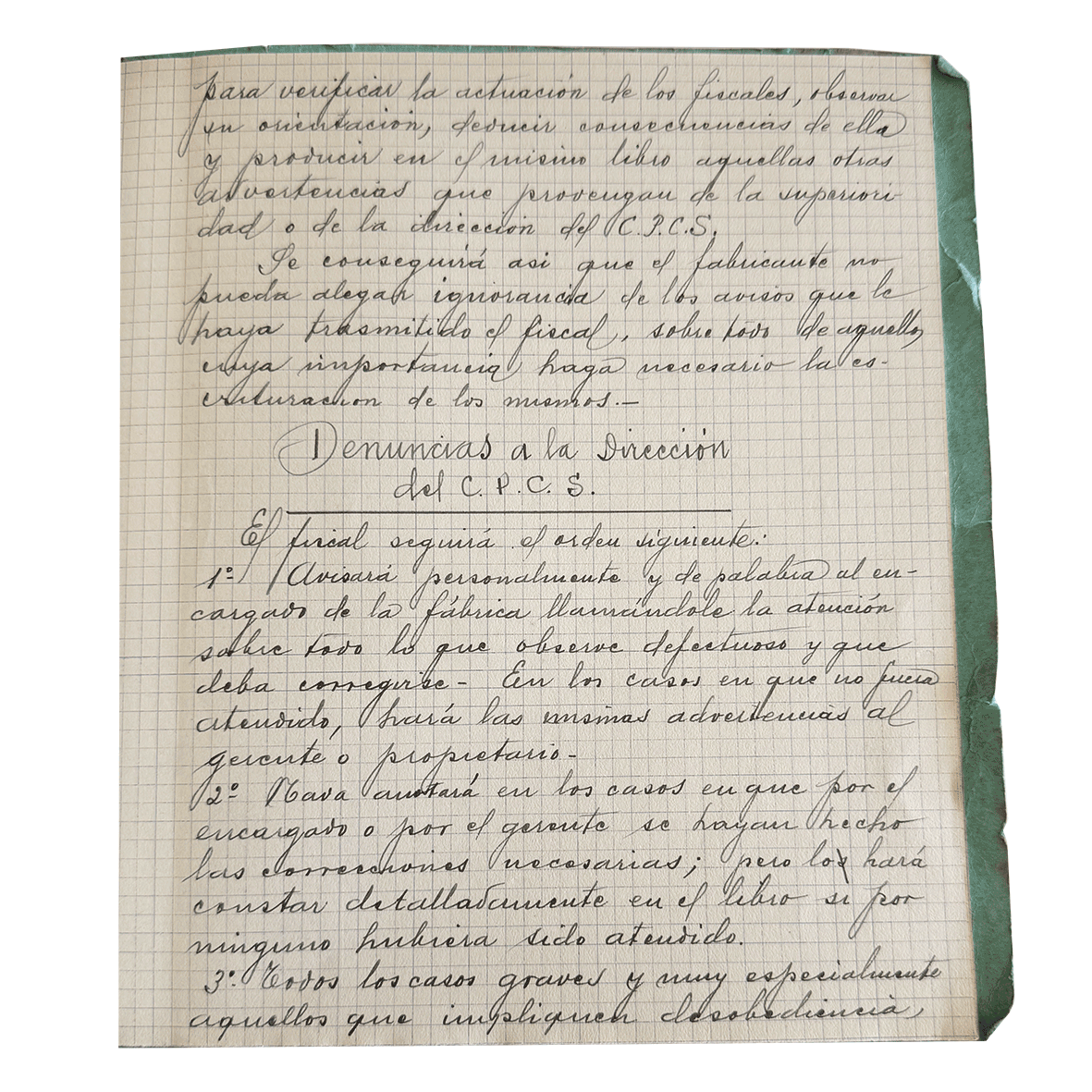
Para verificar la actuación de los fiscales, llaman su atención, formulan observaciones al efecto y pondrán en el mismo libro aquellas otras advertencias que provoquen la superioridad o de la dirección del C.P.C.S.
Se conseguirá así que el fabricante no pueda alegar ignorancia de los casos que le haya transmitido el fiscal, sobre todo de aquellos cuyas importantes haga necesario tales instrucciones de lo mismo.
Denuncias a la Dirección del C.P.C.S.
El fiscal seguirá el orden siguiente:
1.º Avisará personalmente y de palabra al encargado de la fábrica llamándole la atención sobre todo lo que observe defectuoso y que deba corregirse. En los casos en que no fuera atendido, hará las mismas advertencias al gerente o propietario.
2.º Hará constar, en los casos en que por el encargado o por el gerente se hayan hecho las correcciones necesarias; pero lo hará constar detalladamente en el libro si por ninguno hubiera sido atendido.
3.º Todos los casos graves y muy especialmente aquellos que impliquen desobediencia serán anotados en el libro de visitas. Entre estos casos están aquellos que, cuyas nuevas normas, están como sujetos a inflexibilidad.
To verify the actions of the inspectors, drawing their attention, making observations to that effect, and recording in the same book those other warnings that are issued by the higher authorities or the management of the C.P.C.S.
In this way, it will be ensured that the manufacturer cannot claim ignorance of the cases reported by the inspector, especially those whose importance requires such instructions to be issued.
Reports to the Management of the C.P.C.S.
The inspector shall proceed in the following order:
Personally and verbally warn the factory manager, drawing attention to anything observed to be defective and in need of correction. In cases where this is not heeded, the same warnings shall be given to the director or owner.
Record in detail, in the cases where the necessary corrections have been made by the manager or the director; but also record it if none of the issues were addressed.
All serious cases, and especially those involving disobedience shall be recorded in the visitors’ book. Among these cases are those which, according to new rules, are subject to strict enforcement.
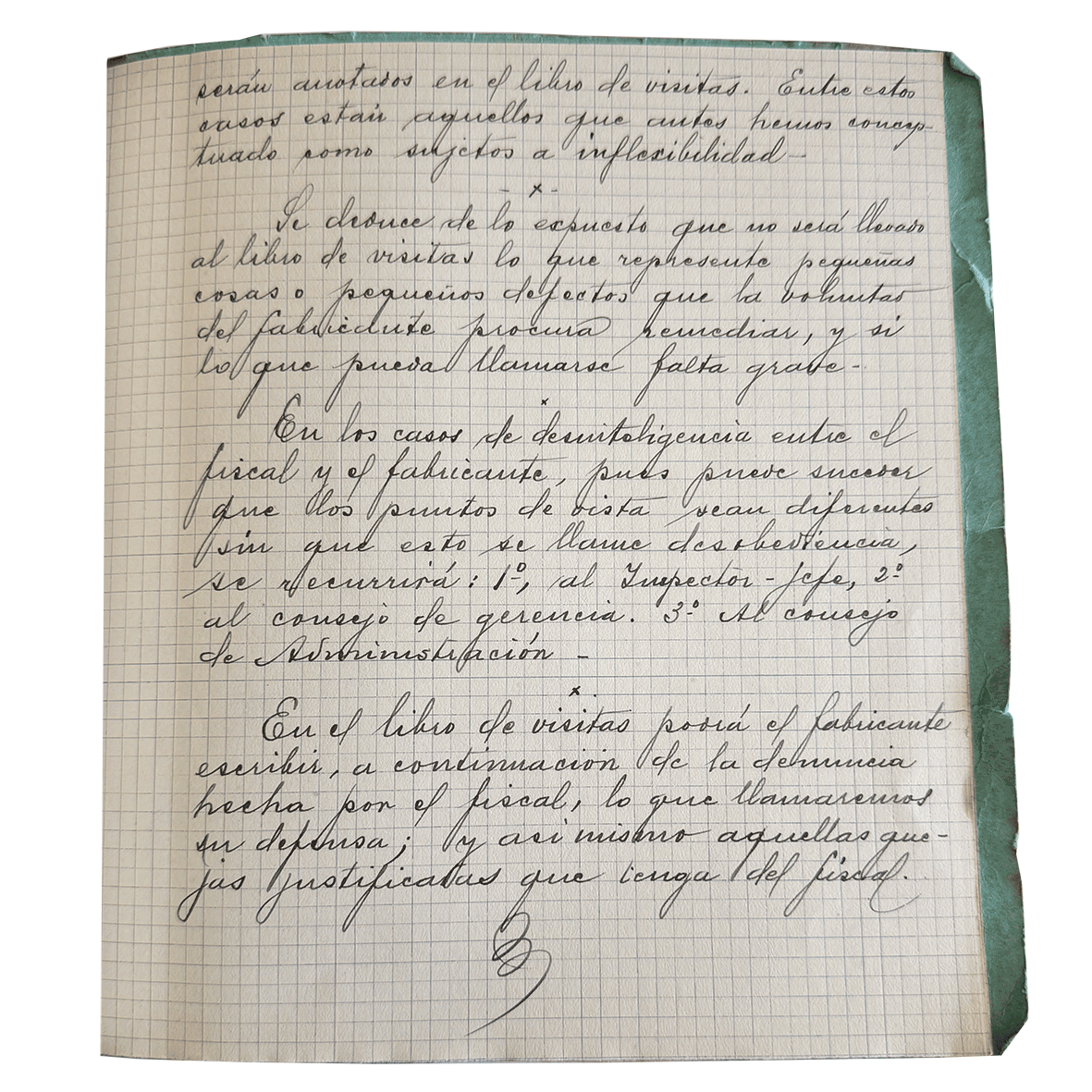
Se observará de la conducta que no sea llevado al libro de visitas lo que represente algunas cosas o pequeños defectos que la voluntad del fabricante procura remediar, y si lo que pueda llamarse falta grave.
En los casos de desinteligencia entre el fiscal y el fabricante, siendo prueba nueva que los puntos de vista sean diferentes sin que esto se llame desobediencia se recurrirá:
1º. al Inspector Jefe,
2º. al Consejo de Gerencia,
3º. al Consejo de Administración.
En el libro de visitas podrá el fabricante escribir a continuación de la denuncia hecha por el fiscal, lo que llamaremos su defensa. Y así mismo aquellas quejas justificadas que tenga del fiscal.
It shall be understood that minor issues or small defects that the manufacturer seeks to remedy should not be entered into the visitors’ book, unless they are deemed serious faults.
In cases of disagreement between the inspector and the manufacturer—provided it is evident that the difference lies in their respective points of view and not in disobedience—the matter shall be referred:
1st, to the Chief Inspector;
2nd, to the Management Council;
3rd, to the Administrative Council.
In the visitors’ book, the manufacturer may write, following the inspector’s report, what shall be considered their defence. Likewise, any justified complaints they may have about the inspector.
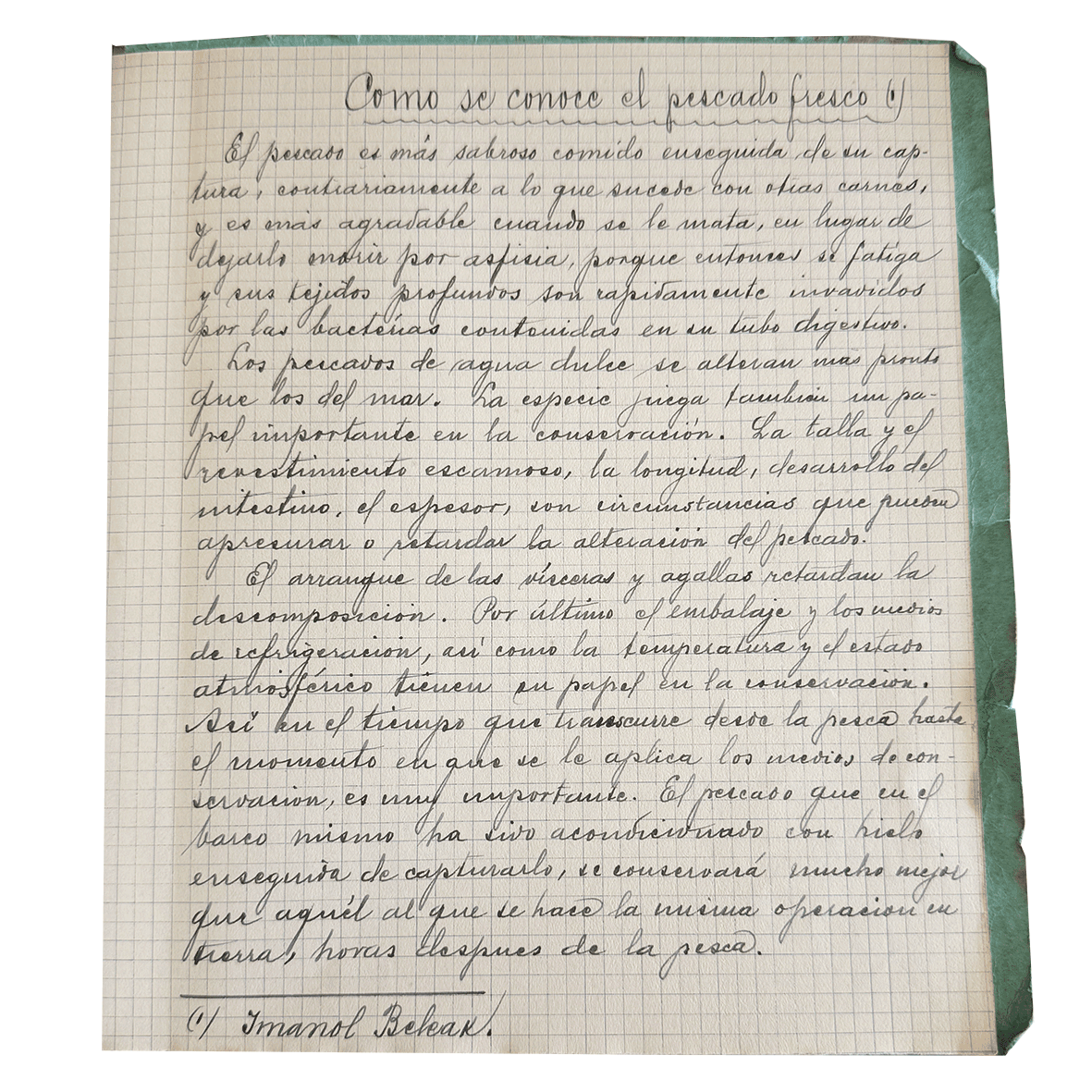
Como se conoce el pescado fresco (1)
El pescado es más sabroso comido enseguida de su captura, contrariamente a lo que sucede con otras carnes.
Es más agradable cuando se le mata en lugar de dejarle morir por asfixia, porque conforme el fatigarse y sus tejidos profundos son rápidamente invadidos por las bacterias contenidas en su tubo digestivo.
Los pescados de agua dulce se alteran más pronto que los de mar. La especie juega también un papel importante en la conservación. La talla y el crecimiento escamoso, la longevidad, desarrollo del intestino, el espesor — en circunstancias que pueden apresurar o retardar la alteración del pescado.
El arranque de las vísceras y agallas retarda la descomposición. Por último, el embalaje y los medios de refrigeración, así como la limpieza y el estado atmosférico tienen un papel en la conservación.
El tiempo que transcurre desde la pesca hasta el momento en que se le aplica los medios de conservación, es muy importante. El pescado que en barco mismo ha sido acondicionado con hielo, enseguida de capturado, se conserva mucho mejor que aquél al que se hace la misma operación en horas, horas después de la pesca.
(1) Imanol Beleak
How to Tell if Fish is Fresh (1)
Fish is tastier when eaten immediately after being caught, contrary to what happens with other meats.
It is more pleasant when killed rather than left to die by asphyxiation, because as it tires, its deep tissues are quickly invaded by the bacteria present in its digestive tract.
Freshwater fish spoil more quickly than sea fish. The species also plays an important role in preservation. The size, scale development, longevity, length of the intestine, thickness — are all factors that may accelerate or delay spoilage.
Removing the guts and gills slows down decomposition. Finally, packaging and refrigeration methods, as well as cleanliness and atmospheric conditions, all play a role in preservation.
The time that passes between the catch and the moment conservation methods are applied is very important. Fish that has been immediately chilled on the boat with ice, right after being caught, keeps much better than that which undergoes the same process hours after fishing.

Se conocen una serie de métodos entre el vulgo para reconocer si el pescado está fresco. El más corriente es la observación de las branquias o agallas, el color, su humedad, o su limpidez; otro dato también es el hundimiento o la suspensión en el agua; si está fresco éste irá al fondo, si está alterado quedará en la superficie.
Sin embargo esta prueba última no nos da seguridad alguna. Igualmente no falla cuando la alteración es profunda y en tal caso hay una serie de signos que sólo la revelan:
Carácteres externos del pescado fresco.
El pescado incluso esté fresco se presenta con un brillo que atenua la transparencia. En reposo en vibración normal sus tintas fuertes y vivas, los reflejos metálicos o irisados, signos muy seguros de frescura.
Estos tintes y reflejos son generalmente muy frágiles y desaparecen por lo general en los indicios de la alteración. La existencia de las escamas implantadas en la superficie y que se desprenden con dificultad, es un buen signo, aunque existen especies como las sardinas, anchoas europeas, etc., cuyas escamas son poco adherentes y se separan con facilidad.
A number of common methods are known among the public to determine whether a fish is fresh. The most common is the observation of the gills, their colour, moisture, or clarity; another method is to see whether the fish sinks or floats in water — if it is fresh, it will sink to the bottom; if altered, it will float to the surface.
However, this last test does not offer complete certainty. It can also fail when spoilage is already advanced, and in such cases, there are a series of signs that can reveal it:
External characteristics of fresh fish.
Even when the fish is fresh, it shows a shine that softens its transparency. At rest and under normal vibration, its colours are strong and vivid, with metallic or iridescent reflections — very reliable signs of freshness.
These colours and reflections are generally very fragile and disappear as soon as spoilage begins. The presence of scales firmly attached to the skin and not easily detached is another good sign of freshness, although there are species, such as sardines, European anchovies, etc., whose scales are naturally less adherent and come off more easily.
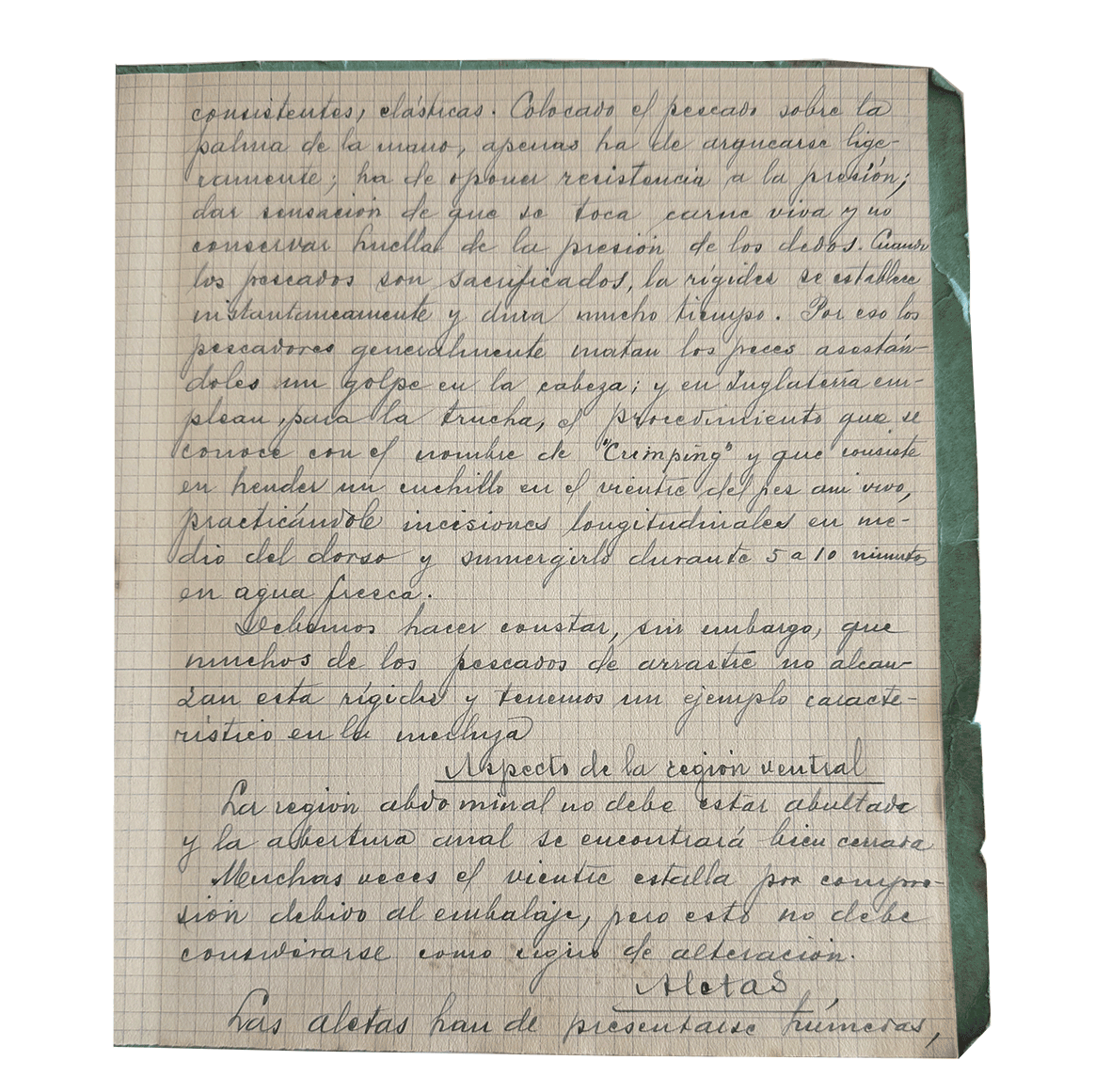
Rigidez:
El pescado fresco debe tener sus carnes firmes, consistentes, elásticas. Colocad el pescado sobre la palma de la mano, apretad hasta asegurarse ligeramente, ha de ofrecer resistencia a la presión, dar sensación de que se toca carne viva, y no conservar huella de la presión de los dedos.
Aun los pescados mal sangrados, si la rigidez se establece instantáneamente, duran menos tiempo.
Por eso los pescadores generalmente matan los peces acostándolos, un golpe en la cabeza; en definitiva, emplean para esta lucha, el procedimiento que se conoce con el nombre de “Crumping” y consiste en heredar un cuchillo en el vientre del pez, practicándole incisiones longitudinales en medio del dorso y sumergirlo durante 5 a 10 minutos en agua dulce.
Debemos hacer constar, sin embargo, que muchos de los pescados de arrastre no alcanzan esta rigidez y tienen un aspecto característico en el melting.
Aspecto de la región ventral
La región abdominosa no debe estar abultada y la abertura anal se encontrará bien cerrada. Muchas veces el vientre estalla por compresión dentro del embalaje; pero esto no debe considerarse como signo de alteración.
Aletas
Las aletas han de presentarse húmedas intactas, bien adheridas y resistentes a la tracción.
Estos signos pueden tener, como la observación de las escamas, un valor relativo, puesto que la forma de pescar con la red, los “cerchings” y similares.
Rigidity:
Fresh fish should have firm, consistent, and elastic flesh. Place the fish on the palm of your hand and press it lightly to check— it should resist pressure, give the sensation of touching live flesh, and not retain the imprint of your fingers.
Even poorly bled fish, if rigidity sets in immediately, will keep for a shorter period.
This is why fishermen generally kill fish by laying them flat and delivering a blow to the head; essentially, they use a method known as “Crumping”, which involves inserting a knife into the fish’s belly, making longitudinal incisions along the middle of the back, and immersing it in fresh water for 5 to 10 minutes.
We should note, however, that many trawl-caught fish do not develop this rigidity and present a characteristic appearance known as melting.
Appearance of the Ventral Region
The abdominal area should not be swollen, and the anal opening should be tightly closed. The belly often bursts due to pressure inside the packaging, but this should not be considered a sign of spoilage.
Fins
The fins must appear moist, intact, firmly attached and resistant to tearing.
These signs, like the observation of the scales, may have relative value, since the fishing method using nets, “cerchings” and similar practices, can alter them.
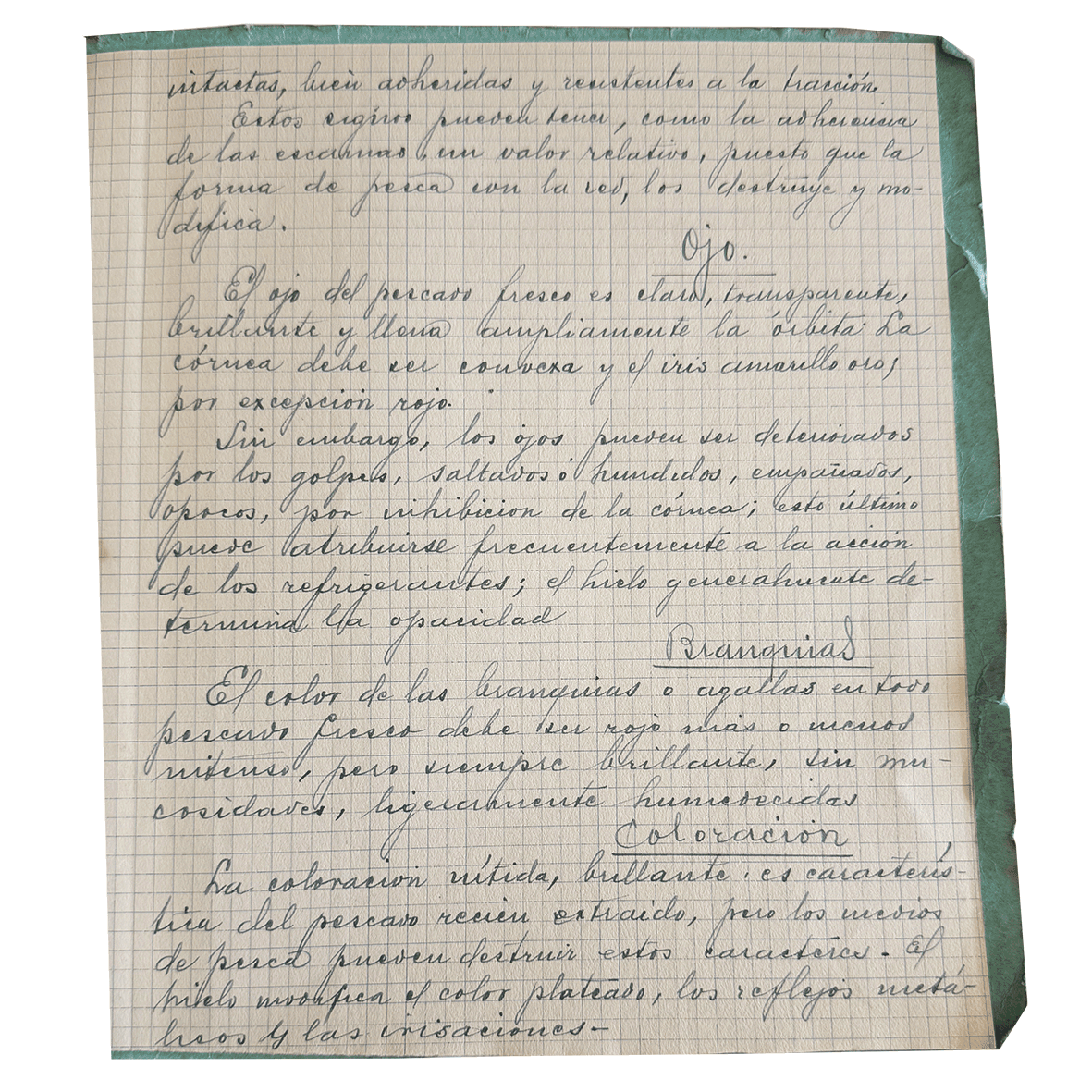
Ojos
El ojo del pescado fresco es claro, transparente, brillante y llena completamente la órbita. La córnea debe ser convexa y el iris amarillo o, por excepción, rojo.
Sin embargo, los ojos pueden ser deformados por los golpes, saltados o hundidos en pescados corpulentos, por inhibición de la circulación; este último signo se atribuye frecuentemente a la acción de los refrigerantes, y el hielo generalmente determina esa opacidad.
Branquias
El color de las branquias o agallas en los pescados frescos debe ser rojo claro o rosado brillante, pero siempre brillante, sin mucosidades, ligeramente humedecidas.
Coloración
La coloración vívida, brillante, característica del pescado recién extraído, por los nuevos no se puede definir como característica.
Muchos muestran colores plateados, los reflejos metálicos y las iridiscencias…
Eyes
The eye of fresh fish is clear, transparent, shiny, and completely fills the socket.
The cornea should be convex, and the iris yellow or, by exception, red.
However, eyes may appear deformed due to blows, bulging or sunken in larger fish, or due to inhibited circulation; the latter is often attributed to the effect of refrigeration, and ice usually causes that cloudiness.
Gills
The colour of the gills in fresh fish should be bright red or pink, but always shiny, without mucous, and slightly moist.
Colouration
The vivid, shiny colour characteristic of freshly caught fish cannot always be used as a defining trait.
Many species naturally show silver tones, metallic reflections, and iridescence…

Olor
Inmediatamente después de la captura, el pescado casi no tiene olor; pero a las dos o tres horas toma un olor acentuado sui generis, que recuerda las plantas marinas, el mar, etc., y que no debe ser desagradable. Cada especie tiene variaciones en su olor.
A este carácter se le da suma importancia y algunos autores lo consideran como el principal para determinar el estado del pescado. Sin embargo, existen algunos, y aun de las rayas es típico, que en estado fresco despiden un olor amoniacal, olor que proviene de la fermentación del mucus abundante que reviste el cuerpo de estos pescados. En la práctica se nota que en tejidos musculares no se advierte ningún olor anormal, lo que comprueba su buen estado.
Sonido
Presionando con el puño u otro instrumento cualquiera sobre el cuerpo de algunos pescados de grandes dimensiones (y aun por ejemplo) se perciben ciertas producciones en ellos, sonidos o macices: si la carne está en buenas condiciones, el fenómeno es más o menos intenso en cada especie.
Smell
Immediately after being caught, the fish has almost no smell; but after two or three hours, it develops a distinctive sui generis odour, reminiscent of seaweed, the sea, etc., and which should not be unpleasant. Each species has its own characteristic smell.
This feature is given great importance, and some authors consider it the main indicator for determining the condition of the fish. However, there are some species—such as certain rays—that typically emit an ammoniacal smell even when fresh. This smell comes from the fermentation of the abundant mucus covering the body of these fish. In practice, it is noted that in the muscular tissues, no abnormal smell is detected, confirming the fish is in good condition.
Sound
When pressing with the fist or another instrument on the body of some large fish (and even others), certain sounds or dull thuds can be perceived. If the flesh is in good condition, the phenomenon is more or less intense, depending on the species.
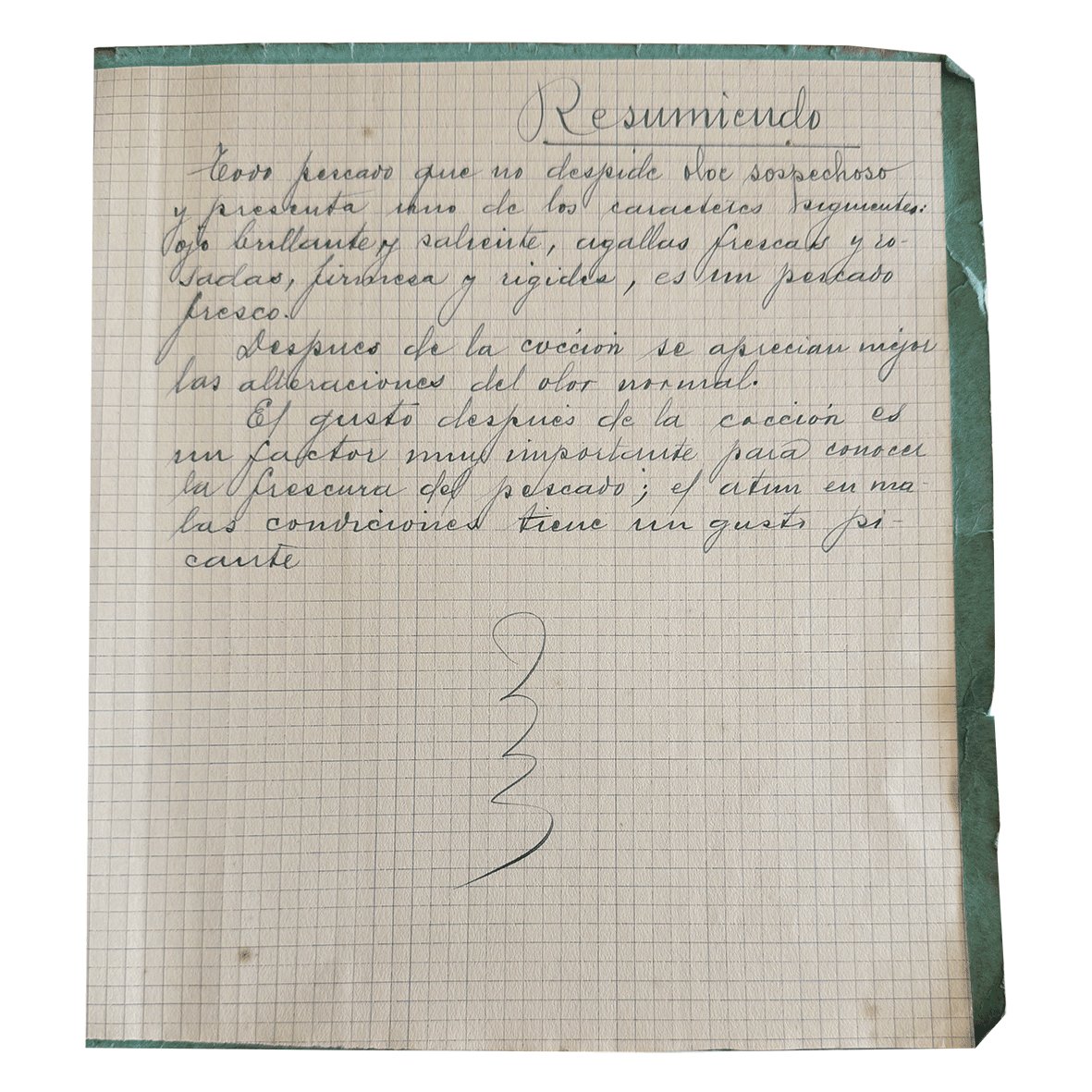
Resumiendo
Todo pescado que no despide olor sospechoso y presenta tres de los caracteres siguientes:
Ojo brillante y saliente, agallas frescas y no lacias, firmeza y rigidez, es un pescado fresco.
Después de la cocción se aprecian mejor las alteraciones del olor normal.
El gusto después de la cocción es un factor muy importante para conocer la frescura del pescado; el atún en malas condiciones tiene un gusto picante.
In Summary
Any fish that does not give off a suspicious smell and shows three of the following characteristics:
Bright and protruding eyes, fresh and non-flaccid gills, firmness and rigidity — is a fresh fish.
After cooking, alterations to the normal smell become more apparent.
The taste after cooking is a very important factor in determining the freshness of the fish; tuna in poor condition has a pungent taste.
